volume 10 | issue 4 | summer 2021




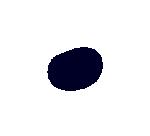










anticipate seeing not only a multitude of excited Jollibee patrons waiting to get their hands on their Jollibee favorites, but also first-timers waiting to have their own Jollibee experience," said Jose Miñana, Jollibee Foods Corporation's Group President for North America. "There's no greater joy for us than serving the needs and tastes of Jollibee fans in the community. At Jollibee, we aim to bring families together for happy moments over great tasting food with superior value, served with warm and friendly service –our own brand of joy." The brand has become a symbol of nostalgia and warm childhood memories for many overseas Filipinos in the U.S. To many, Jollibee is the go-to restaurant of Filipinos for both special
See JOLLIBEE page 15
With the opening, Floridians will get to try Jollibee's signature menu items such as the world famous Chickenjoy. This dish is delicately breaded to be crispylicious on the outside and juicylicious inside. The well-loved Jolly Spaghetti is a favorite of both kids and kids-at-heart because of its signature sweetstyle sauce, loaded with chunky slices of savory ham, ground meat, and hotdog. Other classic menufavorites include the juicy and cheesy Jolly Hotdog, and the Peach Mango Pie, which is made with real Philippine sweet mangoes and a flaky golden brown crust.
ipation and excitement, Jollibee, the largest Asian restaurant company, is now open in Jacksonville. This is the 36th store in the US, as well as the first in the state and Southeast US. It opened to the public on March 18, 2017. Jacksonville is the most populous city in the Sunshine State, as well as home to the largest FilipinoAmerican community in Florida. The longawaited arrival of Jollibee in the city has
THE ENDORSED PUBLICATION OF THE FLORIDA BLUEBERRY GROWERS ASSOCIATION www.FloridaBlueberryGrowers.org
UF/IFAS Blueberry App’s New Cultivar Module BOUNCING BACK Growers Report Rebound After Difficult 2020 ESSENTIAL ELEMENTS Fertilizers for the Necessary Nutrients CHILLI THRIPS CONTROL Detection, Management For the Summer Pest SUMMERTIME CHALLENGES Fight Fungal Leaf Diseases, Algal Stem Blotch
POSTHARVEST edition
PRSRT STD US POSTAGE PAID WEST PALM BEACH,FL PERMIT NO. 4595





2 | The Blueberry News FloridaBlueberryGrowers.org www.ThunderbirdPlastics.com Canada (Main Office): 1.888.778.2473 Western USA: 1.800.297.5201 | East & Central USA: 1.800.809.2035 Choose your style, size, color, and your custom hot-stamped name and logo. UV-resistant Durable Freezer-safe Recyclable Reusable To get your quote call us at: Delivered the best for the best We manufacture the highest quality, industry-proven perfect for harvest, processing, storage and transport. BLUEBERRY CONTAINERS
22
SUMMERTIME CHALLENGES
With the blueberry season over and summer upon us, it’s time to get ready for the diseases that can challenge Florida growers over the next few months. The two primary disease areas to focus on during the summer and early fall months are algal stem blotch and fungal leaf diseases. Learn more about what to look for and how to protect your plants.
28 CONTROLLING CHILLI THRIPS

Summertime in Florida brings with it an important insect pest on blueberries — chilli thrips. This pest typically feeds on new vegetative growth after post-harvest pruning. Damage on foliage can be significant when there are heavy infestations, and control can sometimes be challenging. Although chilli thrips are familiar to many growers, it’s a good idea to review what we know about them and the control alternatives that are available.
34 ESSENTIAL ELEMENTS
There are 17 nutrient elements essential for blueberry production. These essential nutrient elements include nine macronutrients and eight micronutrients. Blueberry plants acquire carbon, hydrogen and oxygen from air and water and all other nutrients from fertilizers and soil. Find out which fertilizers are suitable for blueberry production.
38
Freshly hedged rows line the field at the Durden family’s Central Florida Blueberries farm in Auburndale. With the hustle and bustle of the harvest now behind us, growers are hedging their fields and settling into their summer routines. Many Florida growers reported a strong harvest this season, which was a relief after the challenging season of 2020. Read more on PAGE 20
CULTIVAR SELECTION TOOL AVAILABLE













With the 2021 Florida blueberry season behind us, Florida growers will begin to determine whether they will plant any new blueberry cultivars and/or remove any existing ones. The UF/IFAS blueberry breeding program has developed a new tool to continue its assistance to growers in this task – a cultivar module included as part of the UF/IFAS Blueberry Growers Guide app.




FloridaBlueberryGrowers.org The Blueberry News | 3 Perfectly Balanced Nutrition GET STRONGER, MORE PREDICTABLE GROWTH WITH A BALANCED RATIO OF ESSENTIAL NUTRIENTS IN EVERY GRANULE. Rainbow Plant Food is a homogeneous, granular fertilizer. Precise amounts of each nutrient – primary and secondary- as well as micronutrients, are chemically compounded together ensuring that each granule contains nearly identical amounts of the nutrients your plants need for optimum growth. Your blueberries will get an even distribution of the nourishment required to achieve top quality performance and higher yields. ©2021 Nutrien Ltd; Rainbow, Nutrien logos and designs are registered trademarks owned by Nutrien Ltd. 03/21-74770-6 Discover what Perfectly Balanced Nutrition can do for your blueberries. RainbowPlantFoodProducts.com 74770-06_RBW_2021_PerfectBalance_Blueberry_7-5x5.indd 1 2021-03-25 7:18 AM 4 Executive Director's Letter 6 President's Letter 8 USHBC Update 10 Grower 411 11 Topic of the Season 15 Growers' Thoughts 20 Publisher's Interlude 28 Bug of the Month 33 Classifieds 37 Angle's Letter ON
COVER
THE
POSTHARVEST edition THE ENDORSED PUBLICATION OF THE FLORIDA BLUEBERRY GROWERS ASSOCIATION www.FloridaBlueberryGrowers.org volume 10 | issue 4 | summer 2021 UF/IFAS Blueberry App’s New Cultivar Module BOUNCING BACK Growers Report Rebound After Difficult 2020 ESSENTIAL ELEMENTS Fertilizers for the Necessary Nutrients CHILLI CONTROLTHRIPS Detection, Management For the Summer Pest SUMMERTIME CHALLENGESFight Fungal Leaf Diseases, Algal Stem Blotch Appetizer s: Entrées: Advertisers Directory 2 Appell Pie 2 Calendar Events 10 Classified Ads 14 What’s Going On 3 Analysis:Cateringindustryrevenuesontherise 4 “Big Data” — Doesyourrestaurantneedit? 7 RiseBisquitsDonutstoopeninCoralSprings 11 Del Taco spices up expansion in the Southeast 13 STDPRSRTUS POSTAGEPAID BEACH,FLPALMWEST PERMIT 4595 WWW.TRNUSA.COM VOLUME 21 NUMBER 3 ◆ MARCH 2017 FLORIDA’S FOODSERVICE INDUSTRY NEWSPAPER ◆ $3 FLORIDA EDITION Jollibee's U.S. expansion continues with first Florida location opening Jacksonville, FL After much anticipation and excitement, Jollibee, the largest Asian restaurant company, is now open in Jacksonville. This is the 36th store in the US, as well as the first in the state and Southeast US. It opened to the public on March 18,2017.Jacksonville is the most populous city in the Sunshine State, as well as home to the largest FilipinoAmerican community in Florida. The longawaited arrival of Jollibee in the city has "As Jollibee debuts in Florida, we anticipate seeing not only a multitude of excited Jollibee patrons waiting to get their hands on their Jollibee favorites, but also first-timers waiting to have their own Jollibee experience," said Jose Miñana, Jollibee Foods Corporation's Group President for North America. "There's no greater joy for us than serving the needs and tastes of Jollibee fans in the community. At Jollibee, we aim to bring families together for happy moments over great tasting food with superior value, served with warm and friendly service our own brand of joy."Thebrand has become symbol of nostalgia and warm childhood memories for many overseas Filipinos in the U.S. To many, Jollibee is the go-to restaurant of Filipinos for both special been the talk of the town since 2016. With the opening, Floridians will get to try Jollibee's signature menu items such as the world famous Chickenjoy. This dish is delicately breaded to be crispylicious on the outside and juicylicious inside. The well-loved Jolly Spaghetti is favorite of both kids and kids-at-heart because of its signature sweetstyle sauce, loaded with chunky slices of savory ham, ground meat, and hotdog. Other classic menufavorites include the juicy and cheesy Jolly Hotdog, and the Peach Mango Pie, which is made with real Philippine sweet mangoes and a flaky golden brown crust. See JOLLIBEE page 15 and sustainable sourcing, local and seasonal produce, and global flavors and forms, all done within the steakhouse format showcasing cuts of meat as entrées with choice of sides. Moreover, new menu categories (such as flatbreads) and service elements freshen the concept. About the Report 2017 Forecast: Culinary Trend Tracking Series offers an outlook on the culinary trends—the foods, dishes, ingredients and flavors—that Packaged Facts expects to grow in popularity in 2017. Rockville, MD When comes to American cuisine, there are few things more iconic than steakhouses. The slabs of marbled meat, the sizzling grills, the oozing butter, and the dripping bravado, maybe even cowboy hat or two for ambiance—it's enough to make even fictional steakophile Ron Swanson misty-eyed. Yet for all the traditional steak dinners ordered daily, there are restaurants nationwide pushing the concept of the all-American steakhouse to new culinary heights, according to market research firm Packaged Facts in the brand new report 2017 Forecast: Culinary Trend Tracking Series. "The steakhouse is back and will capture our attention in 2017. Not that the classic restaurant style ever disappeared, but renewal of the model is taking place in response to new sources of beef and new flavorful expressions of the concept that get chefs and diners excited," says David Sprinkle, research director, Packaged Facts. Today's steakhouse menus increasingly feature grass-fed cattle, locally raised animals, heritage varieties, meat butchered and dry aged in-house, and dishes that stem from the whole animal, not just the premium cuts. And that's just the meat. Creative side dishes in lieu of old standards, global and seasonal flavors, and wider menu selection also distinguish these new school operations. Chefs and consumers both want their meat to taste delicious and to feel good about its’ consumption, too. This new breed of steakhouse broadcasts its mission to support local ranchers, factor in sustainability and animal welfare, and create dining experience that showcases culinary flair, not just a grill master's skill at cooking steak to the requested doneness. These operations are also designed to be more inclusive, more of a great place for all kinds of people to dine well, not just traditionminded men on expense accounts. As result, the modern steakhouse is increasingly similar to other modern restaurants with focus on distinctive 2017 forecast:Steakhouses beef up menus with new twists on American classics See STEAKHOUSE page 11
photo by JOHN MAGEE
photo by BRITTANY LEE
Unprecedented Success in Unprecedented Times
UNPRECEDENTED IS A WORD that oddly seems to be used with regularity when describing things related to the Florida blueberry industry. In the past several years, we have seen unprecedented volumes of Mexican blueberries in the Florida window. Last year, there was an unprecedented global pandemic that affected distribution, and sales during that first week of April came to an unprecedented halt. We have unprecedented weather events, and at times there have been unprecedented demand and challenges with the H2A program… the list goes on.
Another unprecedented event in 2020 was when the US Trade Representative requested the International Trade Commission self-initiate a Section 201 Global Safeguard Trade Investigation of Blueberry imports. As you know, the ITC found there was not sufficient injury to rule in favor of the domestic producers.
Now that we have finished the 2021 season, a season in which market stabilization and Florida production relatively returned to normal, we must focus on the future — the future of Florida Blueberries, the future of the domestic industry and how we can remain united as Florida growers but collaborate as global blueberry producers to reach a place of sustainability, where we can co-exist with whatever production pressures we may encounter.
The United Blueberry Task Force has been organized by the North American Blueberry Council (NABC). This task force will work together to solve the industry’s most important problems. YOUR most important problems. The task force will be working to ensure a united and cohesive industry, build new programs that grow the industry and provide positive returns to all industry segments and geographies. Your voice is wellrepresented on the task force.
We know here in Florida that as production in our window increases, so must the demand, and that demand must be at competitive pricing that makes growing blueberries in our state economically viable. We understand that consumers want and need blueberries 52 weeks a year, so we must as an industry and as a task force ensure that blueberries are the preferred berry placed in consumer’s shopping carts.
As USHBC and NABC look forward and continue to develop plans that will benefit Florida growers, plans that will stabilize market volatility and increase consumer demand, we must also as growers continue to explore innovative practices like machine harvesting, reduce our costs where possible and replant old acreage with new releases from Dr. Munoz at the UF-IFAS blueberry breeding lab that are high-yielding and better suited for the current industry needs.
The unprecedented events and anomalies will surely not come to an end, but I know that the future of our industry will be one of unprecedented strength, unprecedented stability and unprecedented consumer demand for Fresh From Florida Blueberries.


Brittany H. Lee
Brittany H. Lee, Executive Director, Florida Blueberry Growers Association fbga.ed@gmail.com
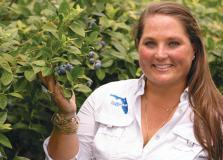
PUBLISHER
Nelson Kirkland
MANAGING EDITOR
Jessica McDonald
MARKETING DIRECTOR & DIGITAL SPECIALIST
Morgan Driggers
ACCOUNT EXECUTIVE






Juanita Halter
LIAISON EDITORS
Brittany H. Lee, Doug Phillips, Jeff Williamson, Oscar E. Liburd
CONTRIBUTING WRITERS
Doug Phillips, Jeff Williamson, Oscar E. Liburd, J. Scott Angle, Philip F. Harmon, Patricio Munoz, Paul Catala, Guodong Liu
CONTRIBUTING ARTISTS
Dawn Lewandowski, Lori Kornilow
DELIVERY
DLS Distributors
the opinions and claims expressed in advertisements and promotional materials do not necessarily reflect those of the Florida
or



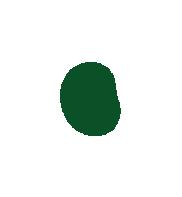

Florida Media Group and do not imply an endorsement.

4 | The Blueberry News FloridaBlueberryGrowers.org executive director’s letter
www.FloridaBlueberryGrowers.com Published by Central Florida Media Group in cooperation with the Florida Blueberry Growers Association Copyright © 2021 Central Florida Media Group. ALL RIGHTS RESERVED. This issue of The Blueberry News is a trademark of Central Florida Media Group. Reproduction or use in whole or in part of the contents of this magazine without written permission is prohibited. The Blueberry News makes every effort to ensure the accuracy of content published. In the event of an error found herein however, neither the publishers or advertisers will be held responsible, nor do the publishers accept any liability for the accuracy of statements made by advertisers in advertising and promotional materials. Furthermore,
Growers
56 Fourth Street Northwest, Suite 100 Winter Haven, Florida
863.248.7537
Blueberry
Association
Central
PHONE

FloridaBlueberryGrowers.org 5
P.O. BOX 358086

Gainesville, FL 32635








352-448-1418


OFFICERS
Brittany Lee, Executive Director fbga.ed@gmail.com
Leonard Park, President president.fbga@gmail.com
Jerod Gross, Vice President fbga.vp@gmail.com
Michael Hill, Secretary michael@handafarms.com

Bobby Barben, Treasurer rhbjr@barbenfruit.com
A Season of Perseverance And Adaptation
Every year Florida Blueberry growers approach the new harvest season with great anticipation dampened somewhat by a cloud of trepidation. There are so many factors at play that can move the outcome from good to bad that growers must be on their toes to steer their farms into and through the white waters of harvest season. We try to control what we can, but weather and the market can play havoc with our best laid plans.
From what I have heard from many Florida growers, our Frogmore Fresh Farm experienced a harvest much like theirs. We are in the hill country of Pasco County in Central Florida so my season recap may resonate with many of you growers, but if not, it may broaden your picture of how the season went for a different grower in a different region. My take is that despite it having some ups and downs, it was a pretty good harvest and will help the industry continue to meet significant upcoming challenges and prosper.
BOARD OF DIRECTORS
Wayne Bass
Jerod Gross
Phil Harmon
Gary Smith
Kyle Straughn
Jeff Williamson
Doug Phillips
Travis Kuhn
Ours started out with way more chill hours than the past several years. We were able to Dormex our crop on time in December with much more favorable weather than December 2019. Our schedule looked good in January. We brought in plenty of bees along with Bumbles then we had a prolonged cool period that slowed the crop a bit but come February we were excited to see a blizzard of flowers but had some cool periods with cloudy weather and rain. Come March, we along with a bunch of other growers, thought we were headed to a record Florida crop. Our disappointment (along with a few other growers) was a dramatic abortion of Meadowlark fruit. We had a massive flower but probably 60% fell to the ground unpollinated. Fortunately we have been reducing our Meadowlark acres and UF breeding has superior new genetics for Florida growers, with more on the way.
Although we saw the fruit coming, our March and early April crop was delayed right when the prices were highest. Our picking curve shifted a week or so behind last year pushing us uncomfortably closer to the Georgia tidal wave of fruit and the concurrent pricing pressure it brings. Despite the big Florida crop and the growing impact of Mexican blueberries on our short market window, pricing held up better than recent years and certainly much better than the pandemic debacle of 2020. Maybe we are getting the word out to consumers and grocer buyers that supporting Florida growers is a good thing and the quality of freshness is a real benefit. If we can keep this momentum in the marketplace we have a brighter future ahead.
Picking weather had its usual challenges in April and May. We grow a lot of Farthing so we pick later than many Florida farms. For us, just when we were beginning our peak Farthing weeks, we took a gut punch with a three-day rain and cloud event with 3 inches of rain. We had a lot of splits and damaged fruit that hit our pack outs for about 10 days until we got back on track, then the weather went hot and dry
Leonard Park President Florida Blueberry Growers Association continued



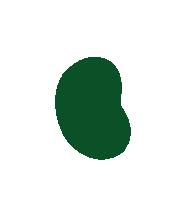
on page 36
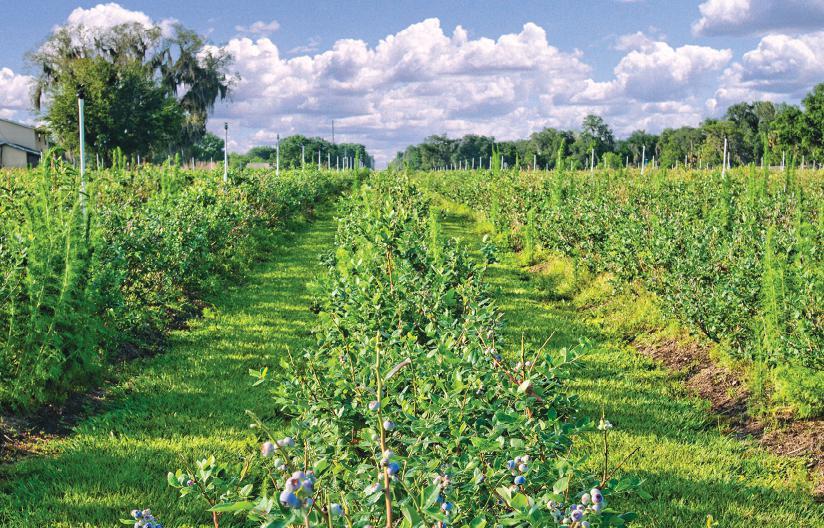
6 | The Blueberry News FloridaBlueberryGrowers.org
president’s letter


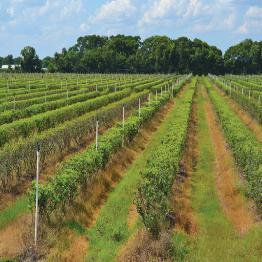


FloridaBlueberryGrowers.org The Blueberry News | 7 Citrus County Blueberry Farm & Acreage INVERNESS, FLORIDA 53.43 ± AC $895,000 Citrus County Blueberry Farm and Acreage is a turn-key blueberry operation with room for expansion. Located north of State Road 44 in Inverness, there are approximately 21 acres allocated to blueberry production and 32 acres in hay production. The acreage in hay production could also be used to expand the blueberry operation or as a homesite adjoining the farm. CONTACT US TO HELP SELL YOUR FARM FLORIDA OFFICE 1723 Bartow Rd • Lakeland, FL 33801 863.648.1528 GEORGIA OFFICE 125 N Broad St, Suite 210 • Thomasville, GA 31792 229.299.8600 FORSALE SOLD SOLD Zellwood Blueberry Farm $874,900 | 50 ± AC Pasco County Blueberry Farm $2,250,000 | 125.80 ± AC
Florida in Unique Position for Global Marketplace
Global demand for blueberries is on the rise, and the United States industry is well-positioned to take advantage of new opportunities in emerging export markets throughout Asia, Europe and the Middle East. As the earliest harvest of the USA blueberry crop, Florida enjoys a unique window of opportunity in the global marketplace for blueberries as one of the only available supplies of fresh highbush blueberries during the months of March and April. Buyers around the world seeking USA blueberries are becoming increasingly aware of the Florida crop and are optimistic about their potential globally.
In emerging markets like Southeast Asia and China, for example, buyers are looking for blueberries during this timeframe because the Southern Hemisphere season (Chile, Australia and South Africa) has ended, and the global supply of blueberries is at its lowest point annually. The only supplies available are from southern highbush growing regions, such as Florida, Mexico and Peru. With the rapidly growing global demand for blueberries, there’s an opportunity for Florida growers to take advantage of this window, especially as the only USA suppliers at this time. By May, production in Georgia, North Carolina and California is in full swing and other international supplies such as Europe and China have begun harvest.
Driving this market growth is the growing demand among international consumers for blueberries. Through USHBC’s increased focus on global marketing efforts and promotional partnerships with international retailers, consumers around the world have learned more about the health benefits of blueberries and are beginning to incorporate all forms of blueberries into their daily diet.
The health halo of blueberries became even more apparent during the global

pandemic, when consumers around the world turned to food to improve their immunity and fight against disease. In fact, according to an international consumer research study conducted by USHBC in early 2021, more than 79% of surveyed consumers in China, Southeast Asia, Vietnam and the Philippines stated that COVID-19 has changed the way that they think about what’s important to them when purchasing food products for themselves or their family, and more than 80% stated they are more concerned about buying food products for themselves and/or their family that are nutritionally beneficial.1
Additionally, demand for blueberries grown in the United States is growing. Origin matters, and the United States has a reputation for producing high quality, safe agricultural products. Another finding from the study revealed that more than 48% of surveyed consumers prefer USA fresh blueberries to other similar fruit products; and quality, health benefits and origin ranked higher than price when asked about purchasing drivers for blueberries among consumers in China, Southeast Asia, Vietnam and the Philippines.2
As evidence, according to the United States Department of Agriculture (USDA) Foreign Agricultural Service (FAS) Global Agricultural Trade System (GATS), total export volume and value of U.S. grown highbush blueberries (fresh, frozen and dried) increased 15% in 2020 compared to 2019, and more significantly up 19% by value and 26% by volume over the previous five-year average (2015-2019).
Several packing facilities in Florida have already begun to take advantage of the growing demand in emerging markets throughout North and Southeast Asia, specifically Vietnam, a new market for USA blueberries that opened in 2019. Three facilities in Florida are registered and
approved to export to Vietnam and shipments began in 2020.
In China, buyers worry that there is not enough supply to meet the growing demand for blueberries among Chinese consumers. While Peru has plans to increase shipments to China, opportunities for USA blueberries are on the horizon, especially for the early and late season supplies from Florida, Oregon, Washington and Michigan, which do not compete as directly with the domestic Chinese crop.
Although fresh blueberries from Florida and Michigan require fumigation prior to export due to concern of blueberry maggot, several Florida blueberry growers participated in a pilot systems approach program in 2021 to demonstrate the effectiveness of an alternative method to methyl bromide, which can shorten the shelf life of blueberries. The United States Department of Agriculture (USDA) Animal and Plant Health Inspection Service (APHIS) will compile results from the pilot program and submit them to China for review. USHBC has coordinated the implementation of this pilot program and hopes that the pilot systems approach protocol will be approved by the 2022 season.
Growers and packers interested in exporting are encouraged to visit USHBC’s Export Webpage at: ushbc.org/for-exporters as well as the Export Database at exportdatabase. blueberry.org for comprehensive market access, technical, consumer and trade data for over 26 countries.
CREDIT by ALICIA ADLER, Vice President, Global Business Development, North American Blueberry Council, U.S. HIghbush Blueberry Council
8 | The Blueberry News FloridaBlueberryGrowers.org
USHBC update
1 Rose Research, “2021 USHBC International Trade and Consumer Evaluation Report,” June 10, 2021
2 ibid
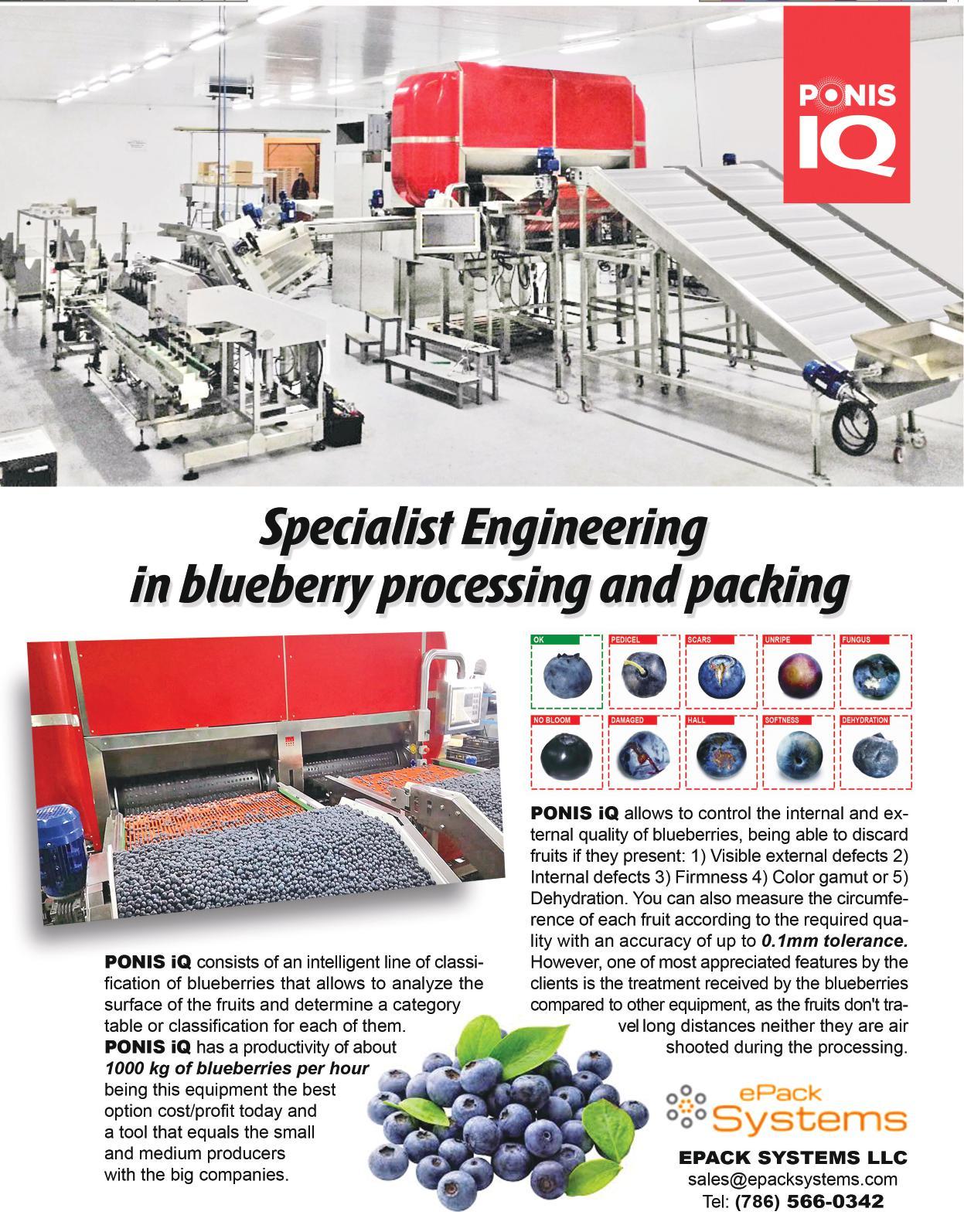
Suggested Blueberry Management Items for Summer and Early Fall

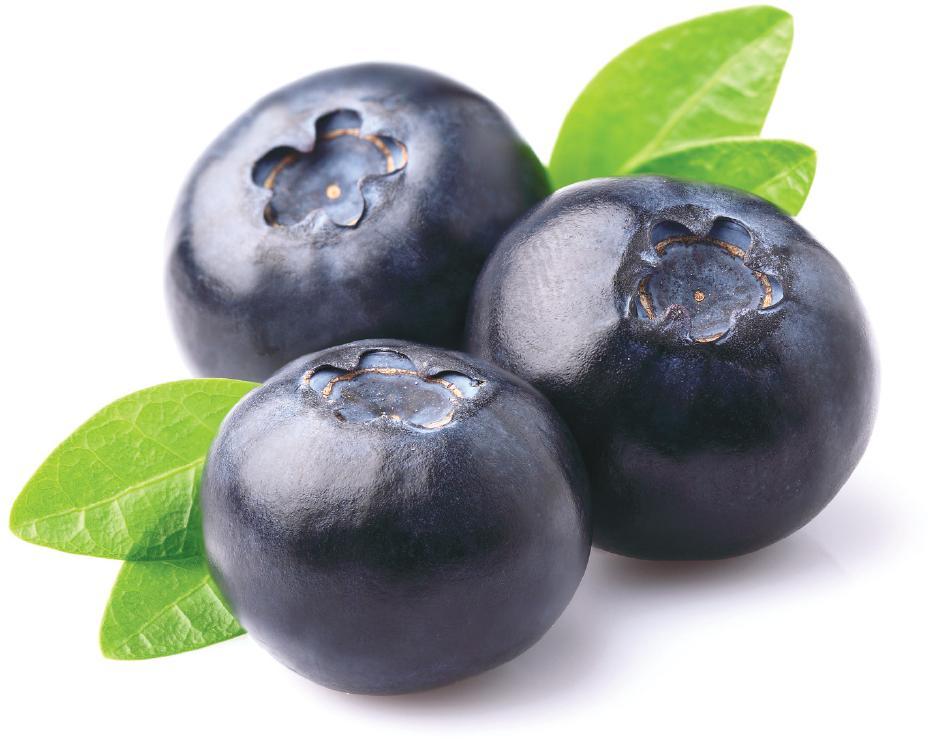
The table below lists suggested blueberry management items for summer and early fall months. Specific disease, insect, and weed controls are listed in the 2019 Florida Blueberry IPM Guide (http://edis.ifas.ufl. edu/pdffiles/hs/hs38000.pdf), as well as in subject-specific publications referenced below.
Also, a list of all UF EDIS blueberry publications can be found at www. blueberrybreeding.com/blog, along with a summary description and link to each.








JULY - SEPTEMBER
Disease Scout for algal stem blotch. See UF EDIS Publication PP344, Algal Stem Blotch in Southern Highbush Blueberry in Florida (http://edis.ifas.ufl.edu/pdffiles/PP/PP34400.pdf). Monitor and manage leaf diseases. See UF EDIS Publication PP348, Florida Blueberry Leaf Disease Guide (https://edis.ifas.ufl.edu/pdffiles/PP/PP34800.pdf). On farms managing bacterial wilt, continue monthly through-irrigation or banded bed applications of a phosphorous acid product. See UF EDIS Publication PP332, Bacterial Wilt of Southern Highbush Blueberry Caused by Ralstonia solanacearum (https://edis.ifas.ufl.edu/pdffiles/PP/PP33200.pdf).
Insect Pests
Scout for flea beetles, larval citrus root weevil (by pulling out dead or dying plants and examining the roots and surrounding soil/bark), larval flatheaded borer, chilli thrips, southern red mites, and flat mites and apply recommended control measures if present. See UF EDIS Publications ENY999, Diaprepes Root Weevil on Southern Highbush Blueberry in Florida (https://edis.ifas.ufl.edu/ pdffiles/IN/IN124100.pdf) and ENY1006, Mite Pests of Southern Highbush Blueberry in Florida (https://edis.ifas.ufl.edu/pdffiles/IN/IN128400.pdf).
Leaf
Tissue Samples
Leaves should be collected for tissue nutrient analysis in July if not done during June. Select samples from fully expanded leaves in the middle of a recent summer growth flush.
Weeds July - Apply post-emergence herbicide if weeds are at densities that hinder bush growth. August - Apply pre-emergence herbicide if summer rainfall has been heavy. Apply post-emergence herbicide if weeds are at densities that hinder bush growth. September - Apply a pre-emergence herbicide for cool season weeds (tank mix with a post-emergence herbicide if weeds are at a density that hinders bush growth).
10 | The Blueberry News FloridaBlueberryGrowers.org
______ CREDIT
by DOUG PHILLIPS, UF/IFAS Blueberry Extension
of the season
Management Strategies for Post-Harvest
by JEFFREY G. WILLIAMSON, Horticultural Sciences Department, PHILIP F. HARMON, Department of Plant Pathology, OSCAR E. LIBURD, Entomology and Nematology Department, and PETER DITTMAR, Horticultural Sciences Department, all with the University of Florida/IFAS.

The following tables were updated from the 2019 UF/IFAS Florida Blueberry Integrated Pest Management Guide found at edis.ifas.ufl.edu/hs380. This publication is intended for use only as a guide. Specific rates and application methods are on the pesticide label, and these are subject to change at any time. Always refer to and read the pesticide label before making any application! The pesticide label supersedes any information contained in this guide, and it is


POLLINATOR PROTECTION
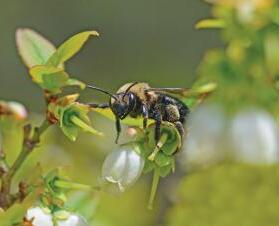
Before making insecticide applications, monitor insect populations to determine if treatment is needed. If insecticide application is necessary:
1. Use selective pesticides to reduce risk to pollinators and other non-target beneficial insects.
2. Read and follow all pesticide label directions and precautions. The label is the Law! EPA now requires the addition of a “Protection of Pollinators” advisory box on certain pesticide labels. Look for the bee hazard icon in the Directions for Use and within crop specific sections for instructions to protect bees and other insect pollinators.
3. Minimize infield exposure of bees to pesticides by avoiding applications when bees are actively foraging in the crops. Bee flower visitation rate is highest in early morning. Apply pesticides in the late afternoon or early evening to allow for maximum residue degradation before bees return the next morning. Bee foraging activity is also dependent upon time of year (temperature) and stage of crop growth. The greatest risk of bee exposure is during bloom.
4. Minimize off-target movement of pesticide applications by following label directions to minimize off-target movement of pesticides. Do not make pesticide applications when the wind is blowing towards bee hives or off-site pollinator habitats.
TABLE 7. MANAGEMENT STRATEGIES FOR PEST AND DISEASE PROBLEMS IN POSTHARVEST PLANT MANAGEMENT
Blueberry bud mites: This is an occasional pest of blueberries in Florida. Use high-volume (300 gal. per acre), high-pressure (200 psi) applications of a postharvest insecticide/miticide and horticultural oils. In blocks infested with blueberry bud mite, make two postharvest applications using carbaryl. Pruning and removing or destroying old blueberry canes can help reduce bud mite populations. Summer topping or hedging immediately after harvest is a common practice used to manage bush height; this practice also greatly reduces bud mite by removing old, infested fruiting twigs. Blueberry bud mite is a tiny eriophyid mite, best visible with a dissecting microscope. In early ripening cultivars, sanitation in the form of postharvest hedging and cutting back into one- and two-year-old wood should be the primary management response for mite-infested blocks. Postharvest application(s) of carbaryl may be helpful to augment this critical cultural practice.
Imported fire ants: Imported fire ants can be very important pests in orchards, vineyards, or fields. Ant baits employed after harvest into fall as a broadcast treatment should eliminate most, but seldom all, fire ant mounds within treated areas. When ant populations are high, use a dormant or early spring broadcast application in addition to the postharvest application to get better fire ant control. Ant baits are slow acting. They require up to 8 weeks to control active mounds. Worker ants must be attracted to baits so that they will carry the baits back to their colonies. Most ant baits interfere with reproduction, which causes a gradual colony die-off. Extinguish® Professional Fire Ant Bait (0.5% methoprene) is labeled for use on all crop land sites. It is effective, but since it is an insect growth regulator, it is somewhat slower acting than Esteem® Ant Bait (0.5% pyriproxyfen). Ant baits work best when soil is moist but not wet. Active ant foraging is essential. Ideally, temperatures should be warm and sunny. Avoid applying ant baits when conditions are expected to be cold, overcast, rainy, or very hot. Individual mound treatments are most effective when used as needed for the occasional colony that survives broadcast treatments. Mound treatments using insecticide baits should be applied in a circle 3–4 feet from the mound. Do not disturb mounds or place bait directly on top of mounds.
continued on next page
FloridaBlueberryGrowers.org The Blueberry News | 11 topic
topic of the season
continued from previous page
TABLE 7. MANAGEMENT STRATEGIES FOR PEST AND DISEASE PROBLEMS IN POSTHARVEST PLANT MANAGEMENT., CONT.
Chilli thrips: Another species of thrips that infest southern highbush blueberries is the chilli thrips, Scirtothrips dorsalis Hood. Chilli thrips were first reported in Florida during summer 2008 in Hernando, Citrus, and Lake Counties. Chilli thrips are smaller than flower thrips, only about 1/4 the size of flower thrips. They have dark-fringed wings and dark spots across the back of the abdomen. They feed on young leaves and stems and are usually found in late spring and summer between the months of May to August. Several growers have reported high populations of Chilli thrips shortly after the bushes are pruned. Adults and larvae feed on young leaves and fruit, causing bronzing, leaf curl stunting, and fruit scarring. Adult chilli thrips have a pale yellow body with dark wings and are less than 1/16 of an inch in length. Females insert their eggs into blueberry tissues, and newly hatched larvae pass through two larval stages that feed on blueberry tissues and fruit. Chilli thrips can be monitored with white or yellow sticky cards placed within the canopy of the blueberry bush.
Allow a minimum of 21 days between application
Blueberry bud mite
Yellownecked caterpillars
Azalea caterpillar
Horticultural oil (JMS StyletOil®) 3–6 qt./100 gal.
Horticultural oil (Stoller Golden Pest Spray Oil)
2 gal. (low volume) application or 2 gal./100 gal. (dilute spray)
Fenazaguin (Magister) +++ 12 h 7 days Apply in at least 50 gallons of water per acre. Use higher rates for heavier mite pressure.
Horticultural oil (JMS Stylet-Oil®)
Horticultural oil (Stoller Golden Pest Spray Oil)
3–6 qt./100 gal. ++ 4 h 0 days
2 gal. (low volume) application or 2 gal./100 gal. (dilute spray)
Blueberry bud mite cannot be readily seen, and by the time symptoms are observed in the spring, the mites are too deep for effective treatment. Avoid using this product if the temperature is above 85°F
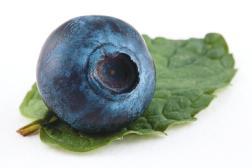

++ 4 h 0 days Avoid using this product if the temperature is above 85°F
Malathion (Malathion 57 EC) 1.5 pt. +++ 12 h 1 day
Bacillus thuringiensis [BT] (DiPel® DF)
0.5–1.0 lb. ++ 4 h 0 days
Foliage-feeding caterpillars become more difficult to control as they mature.
DiPel® is an effective microbial insecticide. However, it should be applied to small, early stage caterpillars.
continued on page 14
12 | The Blueberry News FloridaBlueberryGrowers.org
Pest/ Problem Management Options Amount of Formulation per Acre Effectiveness (Least = + to most = +++++) REI (restricted entry interval) PHI (postharvest interval) Comments Spider mites Fenazaguin (Magister) 24-36 fl oz/ acre ++++ 12 h 7 days Apply in at least 50 gallons of water per acre. Use higher rates for heavier mite pressure. Fenpyroximate (Portal) 2 pt/acre ++++ 12 h 1 day Growers can make two applications per year Acequinocyl (Kenemite®) 31 fl oz/A +++ 12 h 1 day Do not apply this product through the
irrigation system.
++ 4
0
h
days Avoid using this product if the temperature is above 85°F
++ 4 h 0 days Avoid using this product if the temperature is above 85°F

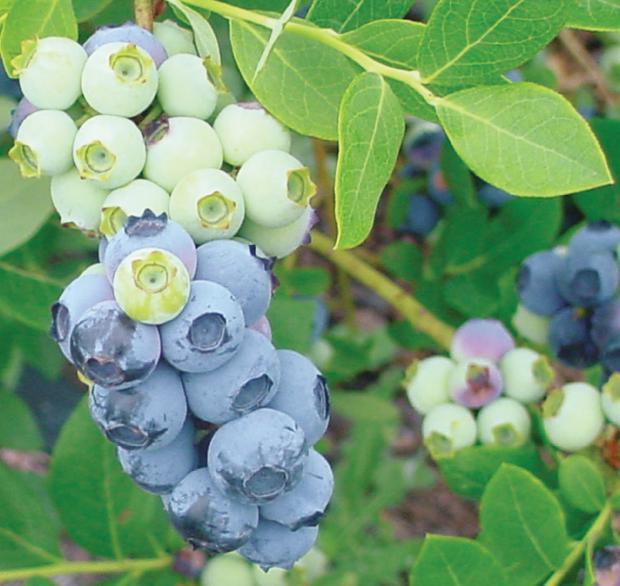

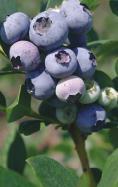
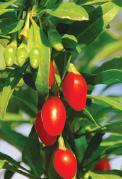


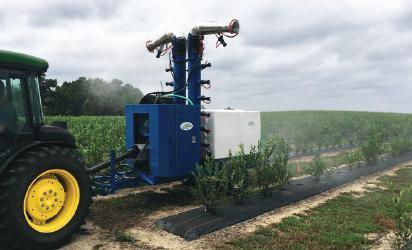




FloridaBlueberryGrowers.org The Blueberry News | 13 Virus indexed plants from tissue culture available in 72ct. cell packs & field ready liners. Agri-Starts, Inc. is a licensed propagator of Florida Foundation Seed Producers, University of Georgia Research Foundation, and University of Arkansas genetics. COME VISIT US ANYTIME! BLUEBERRIES BLACKBERRIES & MORE! AGRISTARTS.COM (407) 889-8055 - info@agristarts.com 1728 Kelly Park Rd. - Apopka, FL 32712 Agristarts Ad 7.5x5.indd 1 9/9/16 5:59 PM CALL FOR A QUOTE TODAY! • 863-293-5420 4202 Hammond Drive • Winter Haven, FL 33881 • AirtecSprayers.com FOR ALL YOUR BLUEBERRY NEEDS! Type of Sprayers: • Air Boom • Cannon • Herbicide • Double Cannon • Skid w/Gun • Injection Trailers Models: • Single or tandem axle trailers • Tanks sizes - 100 to 500 gal. • Low profile & narrow designs • Single or double cannons A irtec Sprayers Inc
topic of the season
continued from page 12
TABLE 7. MANAGEMENT STRATEGIES FOR PEST AND DISEASE PROBLEMS IN POSTHARVEST PLANT MANAGEMENT., CONT.
Confirm® is very effective if applied to small, early stage caterpillars.
4.8–16 oz.
Esfenvalerate (Adjourn® 0.66 EC) ++++
Diazinon (Diazinon AG500)
Pyriproxyfen (Esteem® Ant Bait)
1 pt./100 gal.
++++
12 h 14 days
12 h 14 days
24 h 7 days
Esfenvalerate should be used as a salvage treatment for large caterpillars. It is very effective, but if used often it encourages scale and mite buildup.
Some users may be allergic to Adjourn®; discontinue use if skin or eyes become inflamed.

1.5–2.0 lb. (2–4 tbsp./ mound)
++++
Imported fire ants
Methoprene (Extinguish® Professional Fire Ant Bait 0.5%)
1–1.5 lb. (3–5 tbsp./ 1000 sq. ft.) (3–5 tbsp./ mound)
+++ 4 h 0 days
Esteem® Ant Bait should be applied during the spring and, if needed, again in the fall. Apply on sunny days when the soil temperature is at least 60°F and the soil is moist. Baits are slow acting but effective. Allow 4 weeks to work. Do not make other imported fire ant treatments for 7–10 days. May need to reapply if heavy, flooding rains occur within 7 days.
Extinguish® Professional Fire Ant Bait (0.5% methoprene) is legal for use on crop land. Caution: Extinguish baits with methoprene plus hydramethylnon are not labeled for use on crop land. Application during the heat of the day or when rain is expected within 6 hours of application will reduce the effectiveness of this product. In areas of heavy infestation, repeat applications may be necessary 10–12 weeks after the initial application.
Flea beetles

Carbaryl (Sevin® 80S)
1–2 lb. +++ 12 h 7
days
Diazinon (Diazinon AG500) 1 pt./100 gal.
++++
4 oz. ++++ 12h 24h
Use
a minimum spray volume of 20 gal. by ground.
Soil application. Chemigation into root zone through lowpressure drip, trickle, or microsprinkler. It is important to moisten the soil (1/2–1 inch of water) prior to application or shortly after application.
14 | The Blueberry News FloridaBlueberryGrowers.org
Pest/ Problem Management Options Amount of Formulation per Acre Effectiveness (Least = + to most = +++++) REI (restricted entry interval) PHI (postharvest interval) Comments
Azalea caterpillar
++++
Tebufenozide (Confirm® 2F) 4–8 fl. oz..
4 h 14 days
Esfenvalerate (Asana® 0.66 EC) ++++
4.8–9.6 fl. oz.
Mound drench. Slowly apply 1 gal. of diluted mixture over and 6 inches around each mound. Apply gently to avoid disturbing ants.
12 h 24 h
Sevin® is also effective against small to medium-sized caterpillars.
5 days 7 days
2.4 oz. +++ 12h 1 day Do
Diazinon is also effective against small to medium-sized caterpillars. Mustang
Max™ (Zeta-cypermethrin)
Assail® 70WP (Acetamiprid)
not make more than four applications per season.
White grubs (Grubs of Asiatic garden beetle, European and masked chafer, and Oriental beetle) 10 fl. oz. +++ 12
Admire® Pro (Imidacloprid)
h 3 days
Sentinel Cultivar to Be Planted In South Florida This Summer
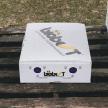
LAST FALL, the University of Florida announced the release of a new southern highbush blueberry cultivar, Sentinel. It is an early, vigorous, high-yielding cultivar that has performed well in both North-Central and Central Florida, with no observed disease issues. It was not previously included in South Florida trial sites, but it will be planted at southern trial locations this summer. Also, machine harvest trials including this cultivar will begin next season. Sentinel has been tested in multiple flavor panels at UF, with tasters giving its flavor a high rating.

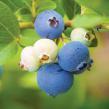

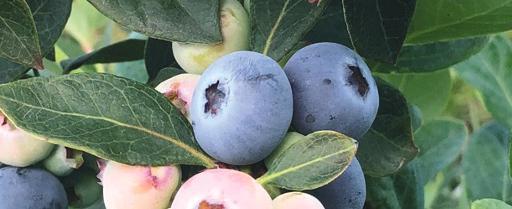
Sentinel Credits: D. Phillips
Sentinel was named to honor Florida blueberry pioneer Alto Straughn. Per Dr. Patricio Munoz, UF assistant professor and head of the Blueberry Breeding and Genomics Program, “A ‘sentinel’ is a watcher or guardian. It is symbolic. We came up with the idea to name the blueberry after Alto because he ‘watched and guarded’ the blueberry breeding program for many years.”

continued on page 36


FloridaBlueberryGrowers.org The Blueberry News | 15
✓ better fruit size ✓ uniform fruit weight and size ✓ reduce your pollination deficit Maximize Pollination with 4-Pak TM Personalized solutions, trusted advice Biobest naturally! www.biobestgroup.com Why use Biobest 4-Pak™? • work through inclement weather; wind, rain and cloud cover • 4-Pak™ works as a complement to current pollination strategies • Bumblebees focus on the targeted crop Biobest USA | Toll free 1 (855) 224 6237 customerservice.na@biobestgroup.com 888.296.7533 . WWW.CARDENINSURANCE.COM We keep you growing... carden SPECIALIZED RISK MANAGEMENT FOR THE AGRICULTURE INDUSTRY . CAR DEN & ASSOCIATES, INC. growers' thoughts
of the season
continued from page 14
TABLE 7. MANAGEMENT STRATEGIES FOR PEST AND DISEASE PROBLEMS POSTHARVEST PLANT MANAGEMENT, CONT.
Delegate® WG may be applied as needed. Delegate® WG should be applied in the early morning. It is toxic to bees in the surrounding areas for the first 3 hours after application.
not make more than four applications per season. Toxic to bees until spray is dry (approximately 3 hours).
should be applied in the early
or late
to reduce the disruption of beneficial insects.
It is toxic to bees in the surrounding areas for the first 3 hours after application.
Sivanto® You should allow a minimum of 7 days between applications.
Apply by ground only. Maximum of 3 applications per season or 81 fl oz/acre/season
TABLE 8. LATE-SEASON & POSTHARVEST BLUEBERRY DISEASE MANAGEMENT


During fruit maturation and/or immediately following harvest, fungicide applications may be warranted for control of leaf spot and suppression of dieback diseases and root rots. Start applications as soon as leaf spots are first observed. Dieback diseases of southern highbush varieties: Most southern highbush varieties are hedged immediately after harvest. Hedging cuts can serve as an entry point for many stem pathogens. At the end of each day of hedging, application of broad-spectrum fungicides such as Captan mixed with Prophyt® may help reduce infection. Resistance to azoxystrobin has been confirmed for Anthracnose stem dieback in central Florida. Do not use Abound as a stand-alone application where resistance is known, but tank mix with Captan or Bravo. Blueberry rust: Rust is a problem in all Florida production areas. On susceptible varieties, rust can prematurely defoliate plants. Where leaves are not dropped in winter, rust can carry over on the previous year's foliage and can cause rust problems in early spring as well. Bravo Weather Stik® is labeled for control of both rust and Septoria leaf spots; this chlorothalonil product makes an excellent rotation partner for the strobilurin-containing product Pristine®. However, Bravo Weather Stik® can only be used after harvest because chlorothalonil will damage fruit.
Make applications after harvest on a monthly interval following bacterial canker use instructions. Ensure good cane coverage and canopy penetration. Do not mix with Aliette, any phosphite fungicide, or any acidifying agents. Do not exceed 28 lb. per acre per year. Copper products provide preventive management of algal stem blotch only. other copper products Many formulations and products that contain copper are labeled for use on blueberry at various rates and application intervals. Carefully follow all label instructions for any product to avoid phytotoxicity. Algal stem blotch is not likely to specifically appear on the label, but these products can be used as long as the crop and site is on the label.
continued on page 18
16 | The Blueberry News FloridaBlueberryGrowers.org
topic
Pest/ Problem Management Options Amount of Formulation per Acre Effectiveness (Least = + to most = +++++) REI (restricted entry interval) PHI (postharvest interval) Comments Algal stem blotch Kocide 3000 1.75–3.5 lb. ++ 48 h 0 days
Pest/ Problem Management Options Amount of Formulation per Acre Effectiveness (Least = + to most = +++++) REI (restricted entry interval) PHI (postharvest interval) Comments Chilli thrips Spinetoram Delegate® WG 6 oz. +++ 4 h 3 days
Acetamiprid Assail® 70WP 2.4 oz. +++ 12 h 1 day Do
Malathion (Malathion 57 EC) 2 pt. +++ 12 h 1 day Malathion
Spinosad Entrust® 80% (labeled for organic use) 1.25–2 oz. +++ 4 h 3 days
morning
evening
Flupyradifurone (Sivanto®) 2-4 fl oz/acre +++ 4 h 3 days
(Apta®) 27.0 fl oz/acre +++ 12 h 3 days
Tolfenpyrad


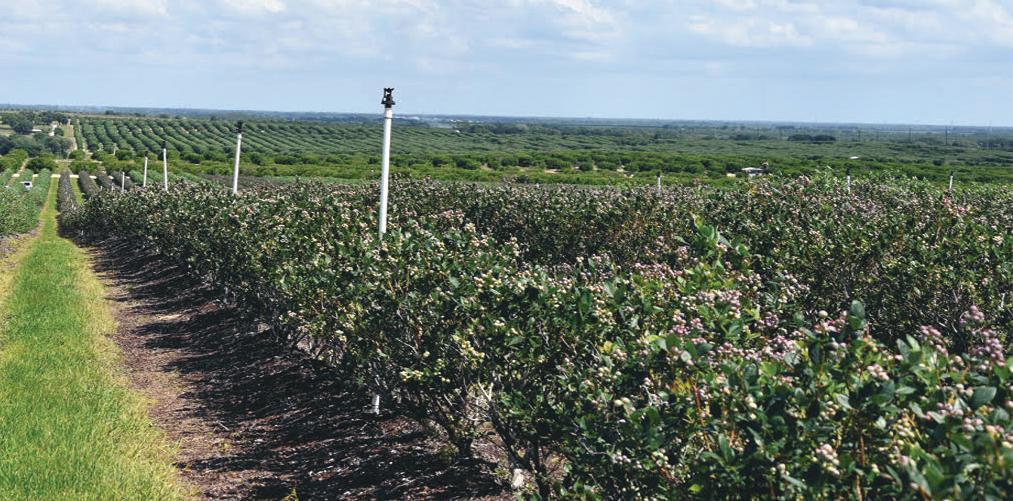




FloridaBlueberryGrowers.org Harvesting. Packing. Marketing. Our company is a wholly owned subsidiary of Dundee Citrus Growers Association which has been in business since 1924. We are a vertically integrated company that offers harvesting, packing and marketing services. Our “Florida Classic” brand is a well-recognized and respected label throughout the United States and Canada. Our packing facility is conveniently located one mile East of Highway 27 in Dundee. steven.callaham@dun-d.com | 863.287.2636 111 1st Street North, Dundee, FL 33838-1739 863.439.1574 office | 863.439.1535 fax DUNDEE BERRY GROWERS ASSOCIATION Currently Accepting New Growers.
topic of the season
continued from page 16
TABLE 8. LATE-SEASON & POSTHARVEST BLUEBERRY DISEASE MANAGEMENT, CONT.
Apply Aliette® as a foliar spray for Phytophthora and Pythium root rots and Septoria leaf spot. Subsequent applications can be made at 14- to 21-day intervals. Two or three fungicide applications following harvest are generally sufficient to prevent major outbreaks of Septoria leaf spot. Assuming that hedging is conducted immediately following harvest, this is a good time to consider an application. Do not exceed four applications per acre per year.
Do not tank mix with copper and foliar fertilizers and do not apply in acidic water or add acidifying agents because these practices could damage fruit or foliage. When tankmixing this product with others, test the mix on a small area to make sure that phytotoxicity does not occur.

Apply as a foliar spray for Phytophthora and Pythium. Also effective against Septoria and anthracnose leaf spots. Do not tank mix with copper and foliar fertilizers and do not apply in acidic water or add acidifying agents because these practices could damage fruit or foliage. When tankmixing this product with others, test the mix on a small area to make sure that phytotoxicity does not occur.
Apply as a foliar spray for Phytophthora and Pythium. Also effective against Septoria and anthracnose leaf spots. Do not tank mix with copper and foliar fertilizers and do not apply in acidic water or add acidifying agents because these practices could damage fruit or foliage. When tankmixing this product with others, test the mix on a small area to make sure that phytotoxicity does not occur.
Septoria and anthracnose leaf spots
Azoxystrobin (Abound®)
6.2–15.4 fl. oz. ++++ 4 h 0 days
Subsequent applications can be made at 14-day intervals. Apply immediately after harvest. Two or three fungicide applications after harvest are generally sufficient to prevent major outbreaks of Septoria leaf spot. When hedging is conducted immediately following harvest, this is a good time to consider an application. Do not exceed 1.44 qt. per acre per season. Do not apply more than two sequential applications of Abound® before switching to a fungicide with another mode of action.
Fluopyram + Pyrimethanil (Luna Tranquility)
16–27 fl oz ? 12 h 0 days
Do not apply more than 54.7 fl oz per acre per year. Rotate to a different fungicide group after no more than 2 applications. Reapplication interval is 7 to 14 days. No efficacy data for this product are available for blueberry in Florida. Only Luna Tranquility is labeled by supplemental label for blueberry in Florida.
continued on page 26

18 | The Blueberry News FloridaBlueberryGrowers.org
Pest/ Problem Management Options Amount of Formulation per Acre Effectiveness (Least = + to most = +++++) REI (restricted entry interval) PHI (postharvest interval) Comments Septoria and anthracnose leaf spots and Phytophthora root rot Fosetyl-Al (Aliette® WDG) 5 lb. ++++ 12 h 12 h
Potassium phosphite (Prophyt®) 4 pt. ++++ 4 h 0 days
Mono- and dipotassium salts of phosphorous acid (Agri-Fos®) 2.5 qt. ++++ 4 h
0 days
Blueline BH200

• Blueline Manufacturing designed this berry harvesting machine based on grower input and identified weaknesses of competitive berry harvesters on the market. Our goal from the onset of this project was to reduce the loss of fruit through the collection system. In many cases, according to growers, was up to 20% of the total crop. With a creative way of moving the crop using high volume, low pressure air, we have reduced the loss to the ground by as much as 50%.

• The patented air conveyance system is a key factor. Unique offset picking head. Four-wheel drive with traction control and floatation tires.
BH300 Berry Harvester


• This new and improved, more compact berry harvester is the culmination of years of in-field experience and grower input. This system also incorporates a newly designed collection ear which is much lighter, but very strong, with a wider edge to reduce friction against the plants. Our new collection system uses a rubber “spring block” rather than conventional springs. This system is much simpler to maintain and longer lasting. Coupled with our patented high volume/low pressure air system we feel this is the most efficient self-propelled top loader harvester on the market. It is just one more way Blueline is striving to improve the process of harvesting soft berries while reducing cost and improving productivity.

• The patented air conveyance system is a key factor. Unique offset picking head. Four-wheel drive with traction control and floatation tires.
Kokan 500S Air Berry Harvester


• This is not a Blueline MFG. product, rather a machine that we import. It is not self-propelled like the other machines. This unit is towed by a tractor. The KOKAN 500S provides an innovative, unique and proven Solution for Effective Harvesting for a wide range of fruits including Raspberries, Blueberries, Blackberries and Black Currants. Unlike other industry harvesters, the mechanism of agitating the plants in the 500S is essentially touchless, resulting in minimum fruit bruise and bush damage. The application versatility is accomplished via simple, user friendly adjustments to the machine’s operating parameters. These include independent adjustment of pulsating air jets, velocity and frequency.
• The patented air system is the singular point that separated this machine from all of the rest. The inflatable (air cushioned) catcher ears. Available with independent power supply, either Deutz or CAT.
• Replaces hand harvesting.
509-248-8411 www.bluelinemfg.com 1605 E. Mead Ave. Yakima, WA 98903
Berry Harvesters The latest technology!
NELSON KIRKLAND, Publisher
Harvest And Hope
BETWEEN THE PANDEMIC and the massive onslaught of produce pouring over the Mexican border, it’s safe to say that last year was a test for many of us. Fortunately, God’s grace has lifted Florida blueberry growers up this year and many are reporting a prosperous season and good harvest numbers. But there’s even more good news brewing.
In the wake of a disheartening February decision by the U.S. International Trade Commission declaring that blueberries were not being imported into the country in such quantities as to harm the domestic blueberry industry nationwide, we have reason to be hopeful.
On June 16, U.S. Senators Marco Rubio and Rick Scott, in collaboration with U.S. Representatives Vern Buchanan and Al Lawson, reintroduced legislation to help Florida growers fight unfair trade practices. The Defending Domestic Produce Production Act would allow seasonal agriculture producers to ask federal regulators to investigate unfair foreign trade and seek relief.
Current law requires that growers demonstrate harm as measured from a nationwide and year-round perspective, which precludes seasonal industries.
Rubio reiterated his support for Florida’s growers, saying, “We must ensure the viability of Florida’s fruit and vegetable growers, who for years have struggled to compete with dumped and unfairly priced Mexican imports."
Buchanan also weighed in, saying it’s “time to level the playing field and protect hardworking Florida farmers.”
This political support is a sign that the nation and its leaders understand our struggle. They listened when growers testified before the ITC that Mexico’s market share for blueberries had skyrocketed 2,100 percent since 2009, dealing nearly catastrophic blows to our state’s growers.
Keep the faith, friends. Our hard work is appreciated, and there is room yet for the tide to turn.
Bouncing Back
Florida Growers Report Rebound After a Weak 2020
by PAUL CATALA
AT THE END OF MARCH 2021, USDA Market News via Agronometrics, a market performance analysis for the fresh produce industry, was optimistic about the Florida blueberry season.
At that time, Argonometrics’ analysis showed unexpectedly high spot pricing for the 2021 crop than what was reported for the 2019 and 2020 seasons. Fortunately for blueberry growers across Florida, that prediction was right.
Throughout 2021, the prices of blueberries in the North American market remained high, their highest point in weeks 15 and 16 of 2021, where average prices were $5.30 per pound — a 73 percent increase year-on-year.
It’s a bit early to report exact harvest figures for 2021, but according to Brittany Lee, executive director of the Florida Blueberry Growers Association (FBGA), the economic impact of the Florida blueberry harvest for 2021 is predicted to be up to $200 million.
With the coronavirus pandemic in full effect in 2020, that year’s season only yielded about 17.05 million pounds of blueberries on about 5,500 acres, harvested statewide from mid-April through May, according to the FBGA.
Generally, exact blueberry economic impact numbers from the USDA are not released until about a year after a given year’s harvest, adds Lee.
“Pricing was strong through April; I would expect when the official USDA numbers come out, they will show a good year for Florida blueberries,” Lee says about the state’s blueberry revenue for 2021. “We had a solid production year; it was strong statewide.”

In its 2020 State Agricultural Overview, the USDA reported a total

20 | The Blueberry News FloridaBlueberryGrowers.org
season recap
interlude publisher, s
of about 20 million pounds of commercial, utilized blueberries with a commercial production value of $51 million.
By the end of the 2021 season, the FBGA reported Florida’s blueberry growers harvested 21.89 million pounds, not far from the 22.7 million pounds harvested in 2019 before the pandemic hit.
“Growers in 2020 didn’t harvest all of their blueberry production because of depressed pricing due to the coronavirus pandemic, but for 2021, we have bounced back to a more stable year in pricing and production,” adds Lee.
That bounce back was evident in feedback collected by Doug Phillips, UF/ IFAS blueberry extension coordinator based in Balm. He says post-season, he went to growers to ask about their harvest results and found most said they had strong harvests. He says the only issues he heard were related to pollination, which resulted in slightly smaller harvests than expected.
“I think overall, most growers reported production was good and prices stayed pretty stable throughout the season. Every season stands on its own with different issues — weather, insects, disease, the market,” says
Phillips, who’s been with IFAS for 3 ½ years. “For 2022, I think it looks good now. I don’t know why it wouldn’t be good but there are always unexpected events and variables to factor in any season.”
Although not nearly a record for Florida’s blueberry growers and their crops, the market is trending upward again, says Chris Velasco, manager of Blueberry Bunch Farm, LaBelle.
On the farm’s 35 acres, Velasco, says Blueberry Bunch is in its 15th year as a commercial farm and 2021 was the third year Blueberry Bunch offered a u-pick option. There are about 50,000 bushes —

9,000 of those organic, planted this past season — on the property.
Velasco, who lives in Fort Myers, says that after the slow 2020 season, the 2021 harvest – along with u-pick revenue – was more profitable and he feels the upcoming season will continue that trend.
“The market was good; things picked up,” says Velasco.
“There was progress. We hope every year to increase the harvest as more people become aware of the farm. Everything is picking up from 2020.”
Helpful Tool for Growers
The USDA website offers a helpful tool for tracking and assessing blueberry production and shipments. Go to https://marketnews.usda.gov/mnp/fv-home and click on “Movement” under Standard Reports. Select “Run a Custom Report.” On the next page, start choosing the commodity and the time range breakdown for how you’d like your data. While daily reports can give helpful feedback, you can also get the data broken down by weeks or even seasons (by the month).
FloridaBlueberryGrowers.org The Blueberry News | 21
Summertime Challenges
How to Combat Algal Stem Blotch and Fungal Leaf Diseases

With the blueberry season over and summer upon us, it’s time to get ready for the diseases that will be issues for Florida growers over the next few months. A good scouting tool to use in monitoring for disease in the field is the UF/IFAS Blueberry Growers Guide. Resources in this guide include a diagnostic key, descriptions of symptoms, disease/insect life cycles, suggested management practices, an image gallery, and links to UF/IFAS blueberry extension publications.
The two primary disease areas to focus on during the summer and early fall months are algal stem blotch and fungal leaf diseases.
Algal Stem Blotch
Algal stem blotch, caused by a parasitic green alga (Cephaleuros virescens Kunze), is a significant disease on southern highbush blueberries in Florida. This disease results in stunted plant growth, increased susceptibility to Botryosphaeria stem blight due to cracking stems and canes, and in some cases plant death.
The alga, spread by water splash, is thought to enter the plant through natural or mechanical wounds, or by directly penetrating the plant cuticle. Plants that are stressed by abiotic or biotic factors are more susceptible to infection and subsequent disease development. Once colonies form in the plant, it typically exhibits raised red blotches on young stems, which can enlarge into cankers that encircle the canes (Figure 1). In addition, significant chlorosis of the leaves (pale yellow to white) occurs on infected canes (Figure 2). During hot, humid, and wet summer conditions, reproductive structures emerge, spreading the pathogen to uninfected tissue in the same or adjacent plants. These structures appear as bright-orange feltlike mats or tufts of algal growth, emerging from lesions on young stems and older cane surfaces (Figure 3).
Algal diseases are only problems for blueberry production in Florida but are common problems for tropical crops including avocado, citrus, guava, and many others. Our blueberry management strategies were assembled from
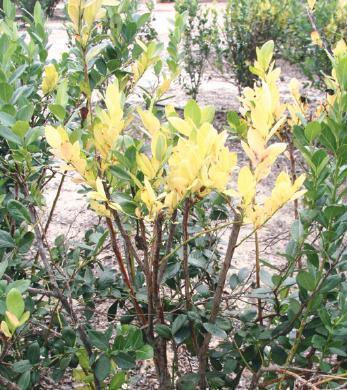
research conducted on those crops and limited blueberry work and observations. Certain cultural practices can help reduce the spread of disease, including use of disease-free planting stock, good management practices to reduce plant stress, avoiding or minimizing the use of overhead irrigation, controlling weeds to promote improved air circulation in the plant canopy, removing and destroying infected canes, and disinfecting pruning equipment. Some varieties develop more algal stem blotch than others, and variety resistance is a direction for future research.
Chemical controls are limited to copper product sprays such as copper hydroxide, which can help protect healthy canes from becoming infected and kill algal spores on the outside of infected plants. These products protect healthy canes from infection for a few days following application, but they cannot impact existing symptoms or eradicate the disease in the plant. A few growers have reported some success in helping minimize spread through spray applications of peroxyacetic acid products, but unlike copper, there are no studies that have shown these products to significantly impact disease spread or development. Most modern fungicides are specific to fungi and have no effect on algae or algal stem blotch.
Copper product applications should begin following harvest and continue through
continued on page 24

22 | The Blueberry News FloridaBlueberryGrowers.org
for the crop
Figure 1. Algal stem blotch lesions.
Credits: P. Harmon
Figure 2. Plant with chlorotic leaves and stunting due to algal stem blotch infection.
Credits: P. Harmon
Figure 3. C. virescens reproductive structures. Credits: D. Phillips


FloridaBlueberryGrowers.org 23
for the crop,cont. from page 22



September. Spray applications must be done on a regular schedule prior to infection in order to be effective, and spray equipment must achieve good cane coverage. Specific spray schedules and application rates vary with the label instructions of the selected product, with reapplication intervals ranging from 7 to 28 days. More frequent applications (usually at the lower label rates) are recommended when weather forecasts are favorable for disease development and when the disease is known to be present on the farm. Caution should be exercised when tank-mixing products that contain copper with anything else, making sure to follow all label directions and warnings. Tank mixes of acidic products or acidifying adjuvants and copper can result in plant burn, and tank mixes of copper products and products with penetrants or spreader sticker type formulations can also be problematic in some conditions (Bravo Weatherstik is an example). For specific product rates, timings and details, see the UF IFAS Blueberry Integrated Pest Management Guide (http:// edis.ifas.ufl.edu/pdffiles/HS/ HS38000.pdf).
More details on algal stem blotch can be found in UF EDIS Publication PP344, Algal Stem Blotch in Southern Highbush Blueberry in Florida (https://edis. ifas.ufl.edu/publication/pp344).
Fungal Leaf Diseases

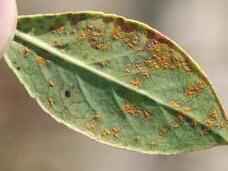
Several fungal leaf diseases can be problems for Florida blueberry growers during the summer months. These include anthracnose, Phyllosticta leaf spot, rust, and target spot.
Symptoms with different causes can have similar appearances, and more than one disease can occur on the same leaf. To know for sure, growers should consult UF IFAS Extension or use a lab-based diagnostic service. Blueberry plant disease samples can be sent to the UF/IFAS Plant Diagnostic Center (https://plantpath.ifas.ufl. edu/extension/plant-diagnosticcenter/) or another diagnostic lab.
Table 1 at the end of this article presents information on when fungal leaf diseases are usually observed, along with some suggested fungicides for disease management.
Anthracnose
Anthracnose leaf spot can cause premature defoliation, poor bud development, and subsequent loss of yield. Symptoms are circular to irregularly-shaped lesions usually at the edges of leaves, expanding from ¼ inch to greater than
¾ inch in diameter. The centers of lesions are necrotic and can be brown to dark-brown, with bull’s eye patterns sometimes present (Figure 4). This disease is commonly observed after harvest in Florida and continues through the summer.
There are several fungicides labeled for anthracnose on blueberry in Florida, including DMI fungicides such as IndarTM, OrbitTM, QuashTM, Quilt XcelTM and ProlineTM. These can be used in rotation or in tank mixtures with compatible products from another group to help prevent fungicide resistance, including Luna TranquilityTM, AboundTM, PristineTM, SwitchTM, and captan. Single applications of BravoTM can also be used after harvest. Applications work best before symptoms become severe. On susceptible varieties, applications to manage foliage health through flower bud differentiation should begin after post-harvest pruning, with reapplications according to label instructions through September. Anthracnose resistance to AboundTM has been confirmed in central Florida, so it should be tank-mixed with another fungicide like a captan product.
Phyllosticta
Phyllosticta leaf spot is more common later in the summer than anthracnose (AugustSeptember). Symptoms are brown leaf spots with irregular borders, surrounded by a purple or dark brown margin, and size ranging from small (less than 1/8 inch) to larger than one inch. A characteristic feature is the presence of tiny black fungal pimples within the lesions (Figure 5), although other fungi can have similar structures. There are no published fungicide recommendations for the management of Phyllosticta leaf spot management on blueberry, although in other crops related diseases are
managed with applications of the contact fungicide BravoTM. Applications are suggested after harvest and approximately every two weeks thereafter (up to 6 weeks) within label instructions.
Rust
Blueberry plants infected with rust can exhibit premature defoliation, decreased floral bud differentiation, and reduced yield. All southern highbush blueberries are susceptible to this disease, although certain cultivars including “Jewel” are known to be more susceptible than others.
Symptoms are typically observed first on upper leaf surfaces as small, somewhat angular yellow to reddish brown spots that may turn black over time before defoliation occurs. Yellow and orange spores are produced on the underside of leaves opposite the lesions on the surface (Figure 6).

Rust spores are spread by wind, and in evergreen systems and protected culture the pathogen can survive in infected leaves that remain attached to the plants throughout winter. New leaf infections can begin in spring during or just after harvest, and disease activity increases again in early fall.
Target Spot
Target spot, caused by Corynespora cassiicola,
continued on page 32
24 | The Blueberry News FloridaBlueberryGrowers.org
Figure 4. Anthracnose leaf spot lesion. Credits: P. Harmon
Figure 6. Rust reproductive spores on the leaf underside.
Figure 5. Phyllosticta leaf spot symptoms. Credits: P. Harmon
John Deere 5075GN


Ultra-narrow Specialty Tractor
The 5075GN is built to operate in Blueberry Farms, with a minimum working width of 49.5” from outside to outside.

The 5075GN has 500-hour engine and 1250-hour transmission service intervals. Adequate service intervals allow more productive time working in the field with reduced hourly costs and reduced maintenance costs over the life of your machine. For

FloridaBlueberryGrowers.org The Blueberry News | 25
more information, please visit: EFE 1963.COM
topic of the season
continued from page 18
TABLE 8. LATE-SEASON & POSTHARVEST BLUEBERRY DISEASE MANAGEMENT, CONT.


Apply only as a postharvest fungicide for Septoria and rust. Do not combine with other pesticides, surfactants, or fertilizers.
Do not make more than four applications or apply more than 8 oz. of Indar® 75 WSP (0.38 lb. active) per acre per year. Indar® 75 WSP belongs to the sterol demethylation inhibitor (DMI) class of fungicides. Alternation with fungicides of different classes is recommended.
Orbit®, another DMI fungicide, may be applied by ground or aerial application (see label). Do not apply more than 30 fl. oz. per acre per season. Orbit® is more effective when it dries ahead of a rain.
No more than two sequential applications of Pristine® should be made before alternating with fungicides that have a different mode of action. Do not apply more than four applications of Pristine® per acre per crop year.
Septoria, anthracnose, and rust leaf spots
5.7 fl oz. ? 12 h 7 days
2.5
? 12 h 7 days
Make up to 2 applications per year on a 7–10 day schedule. A tank mix with Captan is recommended for resistance management and to provide Botrytis suppression.
Do not make more than three applications per acre per crop year. Alternate with a fungicide with another mode of action.
TABLE 9. EFFICACY OF SELECTED FUNGICIDES AGAINST BLUEBERRY DISEASES
continued on page 30
26 | The Blueberry News
FloridaBlueberryGrowers.org
Pest/ Problem Management Options Amount of Formulation per Acre Effectiveness (Least = + to most = +++++) REI (restricted entry interval) PHI (postharvest interval) Comments Septoria and rust leaf spots Chlorothalonil (Bravo Weather Stik®) 3–4 pt. ++++ 12 h (with restrictions) 6.5 days (w/o) 42 days
Fenbuconazole (Indar® 75 WSP) 2.0 oz. +++++ 12 h 30 days
Propiconazole (Orbit® 3.6 E) 6.0 fl. oz. +++++ 24 h 30 days
Pyraclostrobin + boscalid (Pristine® WG) 18.5–23 oz. +++++ 12 h 0 days
Prothioconazole (Proline 480 SC)
Metconazole (Quash®)
oz.
Fungicide [Mode of Action] Phytophthora root rot Mummy berry (grayBotrytismold) Alternaria rot Phomopsis twig blight Ripe rot (anthracnose) Septoria leaf spot Anthracnose leaf spot Rust Azoxystrobin (Abound®) [11] NA ++ NA +++++ ++ +++++ ++++ ++++ ??? Captan (Captan, Captec) [M4] NA + ++ ++ ++ +++ ++ +++ NA Chlorothalonil (Bravo®) [M5] NA Do not use before harvest. NA Do not use before harvest. NA Do not use before harvest. NA Do not use before harvest. NA Do not use before harvest. NA Do not use before harvest. ++++ Do not use before harvest. ??? Do not use before harvest. +++ Do not use before harvest. Cyprodinil + fludioxonil (Switch®) [9+12] NA ++ +++++ +++++ +++ +++++ +++ ++++ ??? Fenbuconazole (Indar®)* [3] *tank mix with captan products during bloom to prevent fruit rots NA +++++ NA NA NA NA ++++ NA +++


FloridaBlueberryGrowers.org The Blueberry News | 27 When one cold night can ruin an entire year’s hard work... It’s best to play it safe. Since 1967, we have hand-crafted our wind machines with precision technology. We take pride in the details, which is why blueberry growers from around the world trust Orchard-Rite® wind machines to protect their mature stock and new plantings from the dangers of frost. We are dedicated to serving you and your crops by providing the tools, knowledge and service to stave off those frosty nights, protecting your harvest and your future. Superior Wind Machine Sales & Service 616-971-8177 orchard-rite.com Authorized Distributor of Orchard-Rite® Wind Machines SUPERIOR WIND MACHINE SERVICE, INC. Over 37,000 SOLD Worldwide!
Controlling Chilli Thrips

Tools Available to Growers
SUMMERTIME IN FLORIDA brings with it an important insect pest on blueberries — chilli thrips. This pest was first recorded in blueberries in Florida in July 2008, and typically feeds on new vegetative growth after post-harvest pruning. Damage on foliage can be significant when there are heavy infestations, and control can sometimes be challenging. Although chilli thrips are familiar to many growers, it’s a good idea to review what we know about it and the control alternatives that are available.
Chilli thrips adults are small (< 1/16 inch in length), around ¾ the size of flower thrips. They have pale yellow bodies with dark fringed wings and dark brown incomplete stripes on the abdomen (Figure 1). The lifecycle of chilli thrips (i.e., egg to adult) is short and typically lasts about 18-20 days at 77-81°F. Eggs usually hatch in 5-8 days, larvae complete their life stages in 8-10 days, and pupa complete their life stages in 2-4 days on the underside of leaves, in leaf litter, or in soil. Adults live for 20-25 days at 77 °F.
Chilli thrips are not strong fliers and are only able to move short distances on their own. However, they can be dispersed over a wide area very quickly due to abiotic factors such as wind or being transported unintentionally by farm workers. They typically form “hot spots” in the fields, moving on to surrounding plants when the amount and quality of foliage available for feeding diminishes. Heavy infestations may occur during prolonged hot and dry periods (June - September) in blueberry.
Damage
Chilli thrips feed primarily on young blueberry foliage during late spring, summer, and early fall (usually beginning in June with the first post-pruning foliar flush). Adults and larvae feed on the cell contents of leaves, leading to tissue necrosis and death. Injury symptoms first appear as bronzing along leaf
veins and petioles, with leaves gradually curling and distorting (Figure 2). Heavy infestations can cause leaf defoliation with significant curling of leaves.
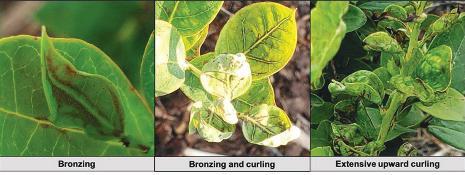
Management and Control
Early detection is essential for effective chilli thrips control. Although the appearance of bronzing on new leaves may be the first indication of chilli thrips presence in blueberry fields, by that time damage has already begun to occur. Scouting or monitoring can be done by checking for adults on young leaves with a 10X hand lens, tapping young foliage onto a white sheet of paper, or using white or yellow sticky cards. Chilli thrips may have an irregular distribution within a field, so the sampling area should be random and broad enough to
accurately estimate the population in the field. An integrated management plan to control chilli thrips includes cultural, biological, and chemical controls. Host plants (including weeds) in or near production fields that support the development of chilli thrips should be removed. Natural predators such as Orius insidiosus (minute pirate bug), which feeds on all life stages of thrips, Amblyseius swirskii (predatory mites), and Geocoris spp. (bigeyed bugs) have shown some effectiveness in managing chilli thrips.
Chemical insecticides are the primary way to manage chilli thrips in blueberry. Insecticides registered for controlling chilli thrips in blueberry include Delegate® (spinetoram), Apta® (tolfenpyrad), Exirel® (cyantraniliprole), Rimon® (novaluron), Assail® (acetamiprid), and Sivanto® (flupyradifurone). Entrust® (spinosad) can be used to manage this pest in organic blueberry production. In a 2020 field trial, Apta® and Assail® were the most effective of the insecticides evaluated. Historically, Delegate® has also been effective against chilli thrips. Several factors could have affected the effectiveness of Delegate during our 2020
28 | The Blueberry News FloridaBlueberryGrowers.org
Figure 1. Adult female chilli thrip.
Photo credits: Babu Panthi
Figure 2. Feeding injury caused by chilli thrips feeding on blueberry leaves.
Photo credits: Babu Panthi
farm management
trial, including age and storage of the product prior to use, error in the application rate, and over-use of Delegate in the system. Based on its past performance, we are still recommending the use of Delegate, but we strongly recommend rotation among pesticide classes for all products that growers are using. Delegate has systemic activity, allowing the chemical to be absorbed into plant tissues relatively quickly, and has been shown to be effective in controlling all life stages of chilli thrips. When mixed with Rimon® it prevents egg development and curtails larval activity. A list of products registered for managing chilli thrips in Florida blueberries along with their active ingredients and insecticide classes are provided in Table 1. Be sure to follow all insecticide label instructions, including rotating appropriate products with different modes of action to help minimize the development of insecticide resistance.
Additional information on chilli thrips can be found in UF EDIS Publication ENY-2053, Chilli Thrips on Blueberries in Florida (https:// edis.ifas.ufl.edu/publication/IN1298).
POWER THROUGH COMMERCIAL CUTS QUICKER & EASIER
IRAC
CODE1 CHEMICAL GROUP ACTIVE INGREDIENTS REGISTERED PRODUCTS
1B Organophosphates Malathion Malathion 57EC
Diazinon Diazinon 50W, AG600 WBC
3A Pyrethroids Pyrethrins PyGanic EC 5.0, Azera
Fenpropathrin Danitol 2.4 EC Bifenthrin Brigade WSB
4A Neonicotinoids Acetamiprid Assail 70WP
4D Butenolides Flupyradifurone Sivanto 200 SL, Prime
5 Spinosyns Spinetoram Delegate WG Spinosad Entrust (for organic use)
15 Benzoylureas Novaluron Rimon
21A Phenylpyrazole Tolfenpyrad Apta
28 Diamides Cyantraniliprole Exirel
UN - Azadiractin Aza-Direct, Neemix 4.5% EC
UN - Beauvaria bassiana strain GHA BotaniGard ES, Mycotrol ESO
UN - Chromobacterium subtsugae strain PRAA4-1 Grandevo
UN - Metarhizium anisopliae strain F52v
THE CLASSIC
The Classic is the ultimate mowing machine with the perfect combination of commercial quality with industrial features





FINANCING AVAILABLE
HIGH PERFORMANCE PACKAGE: Comes standard on select models
OCDC: Open and close the discharge chute on command
PUMPS & WHEEL MOTORS: Stronger transmissions for extended
system life
HEAVY-DUTY SPINDLES & COOLING FANS: Keep spindles and belts cool 50”, 60”, AND 72” ELITE X DECK: Handles all grass types in any
situation
POWER AND MORE POWER: Powered by industry preferred Kawasaki® engines with options up to 35 horsepower to tackle through the tough jobs with ease

MET52 EC
UN - Isaria fumosoroseus Apopka strain 97 PFR-97 20%WDG*
1Insecticide Resistance Action Committee (IRAC) Mode of Action
Classification v. 8.2 March 2017. Source (Vegetable Production Handbook of Florida, 2017-18).
CREDIT by OSCAR E. LIBURD, Professor and Program leader, Fruit and Vegetable Entomology , University of Florida & DOUG PHILLIPS, Blueberry Extension Coordinator, University of Florida
FIELDSEQUIP.COM

FloridaBlueberryGrowers.org The Blueberry News | 29
DIXIE CHOPPER MOWERS
LIM I TED
3440 US HWY 17 SOUTH • ZOLFO SPRINGS, FL 33890-0837 (863) 735-1122 3203 HAVENDALE BLVD • WINTER HAVEN, FL 33881 (863) 967-0602 17215 HWY 27 NORTH • MINNEOLA, FL 34715-9273 (352) 394-7181
Table 1. Registered products for managing chilli thrips in Florida blueberries.
topic of the season
continued from page 26
TABLE 9. EFFICACY OF SELECTED FUNGICIDES AGAINST BLUEBERRY DISEASES, CONT.

continued on page 32

30 | The Blueberry News FloridaBlueberryGrowers.org
Fungicide [Mode of Action] Phytophthora root rot Mummy berry (grayBotrytismold) Alternaria rot Phomopsis twig blight Ripe rot (anthracnose) Septoria leaf spot Anthracnose leaf spot Rust Fenhexamid (Elevate®) [17] NA ++ +++++ NA NA NA NA NA NA Fenhexamid + captan (Captevate®) [17+M4] NA ++ +++++ ++ ++ +++ ++ ??? NA Fluazinam (Omega 500F) [29] NA NA ++ ++ +++ +++ NA NA NA Fluopyram + pyrimethanil (Luna Tranquility) [7+9] NA ? ? ? NA NA ? ? NA Fosetyl-Al (Aliette® WDG) [33] +++ NA NA NA + + ++++ +++ NA Mefenoxam (Ridomil Gold®) [4] +++ NA NA NA NA NA NA NA NA Metconazole (Quash) [3] NA +++++ ??? ??? ++++ ??? ++++ ++++ ++++ Mono- and dipotassium salts of phosphorous acid (Agri-Fos®, K-Phite®) [33] +++ NA NA NA NA NA ++++ ++++ NA Potassium phosphite (ProPhyt®) [33] +++ NA NA NA NA NA ++++ ++++ NA Propiconazole (Orbit, Tilt, Bumper, PropiMax [3] NA +++++ NA NA NA NA ++++ ??? +++ Prothioconazole (Proline) [3] NA +++++ NA NA ??? ??? ++++ ??? +++ Pyraclostrobin + boscalid (Pristine®) [11 +7] NA ++++ +++++ +++++ +++ +++++ +++++ +++++ +++++ Ziram (Ziram) [M3] NA + ++ + +++ +++ ??? ++ ??? NA = no significant activity, ??? = unknown activity, + = very limited activity, ++ = limited activity, +++ = moderate activity, ++++ = good activity, +++++ = excellent activity
MEMBERSHIP INFORMATION
To join or renew your membership in the Florida Blueberry Growers Association, mail a check payable to: FLORIDA BLUEBERRY GROWERS ASSOCIATION, INC. P.O. Box 358086 Gainesville, FL 32635

•Grower Member: $150 (Florida & out-of-state growers)
Additional Associate Member/Grower: $50 each
•Allied Member: $200 (equipment and chemical companies, etc.)

















Additional Associate Member/Allied: $50 each
•Educational & Research Member: $10 (University and USDA members who do not grow blueberries commercially)



FloridaBlueberryGrowers.org The Blueberry News | 31 Plastic Rentals, Logistic & Management Solutions ■ Daily Bin Rental On-Demand — No Minimum Quantity or Timeframe ■ Citrus Bins, Blueberry Lugs, Peach Tote Rentals ■ Bin Repairs ■ Recycle Program ■ IGPS Pallets Jerry Cummings 863-651-5596 jcummings@palogix.com www.palogix.com CONNECT WITH US • Content Marketing • Niche Publishing • Social Media Management • Content-Focused Website Development • Targeted Marketing • Articles, Whitepapers, E-Books, Reference Guides, Workbooks, and more. centralfloridamediagroup.com (863) 248-7537 info@centralfloridamediagroup.com
“We are an agricultural services advertising company that helps your business attract clients.”
– Nelson Kirkland, founder, Central Florida Media Group
topic of the season
continued from page 30
TABLE 10. FUNGICIDE CLASSES WITH MODERATE TO HIGH RISK OF RESISTANCE DEVELOPMENT (GENERALLY SINGLE SITES OF ACTION).
Fungicide Class
Anilino-pyrimidines [9]
Succinate dehydrogenase inhibitors (SDHI) [7]
Demethylation inhibitors (DMIs) or sterol inhibitors [3]
2,6-dinitroanilines [29]
Hydroxyanilides [17]
Phenylamides [4]
Phenylpyrroles [12]
Trade Name and Chemical Name
Switch® (cyprodinil; one component of a two-part mixture), Luna Tranquility (pyrimethanil; one component)
Pristine® (boscalid; one component); Luna Tranquility (fluopyram; one component)
Indar® (fenbuconazole), Orbit® (propiconazole), Proline (prothioconazole), Quash (metconazole)
Omega (fluazinam)
Elevate® (fenhexamid)
Ridomil Gold® (mefanoxam)
Switch® (fludioxanil; one component)
Strobilurins or QoI (quinone outside inhibitors) [11] Abound® (azoxystrobin)
TABLE 11. FUNGICIDE CLASSES WITH LOW RISK OF RESISTANCE DEVELOPMENT (GENERALLY MULTIPLE SITES OF ACTION).
Fungicide Class
Coppers Coppers (numerous formulations)
Dithiocarbamates Ziram (ziram)
Phthalimides Captan (Captan or Captec)
Phthalonitriles Bravo® (Chlorothalonil)
Trade Name and Chemical Name
Phosphonates Aliette® (Fosetyl-Al), Agri-Fos® (Mono- and dipotassium salts of phosphorous acid), K-Phite® (Mono- and dipotassium salts of phosphorous acid), ProPhyt® (Potassium phosphite)
for the crop,cont. from page 24
has become an increasingly problematic disease for Florida blueberry growers. It was first reported in blueberries in the US in 2014, and Florida growers have observed severe defoliation on many SHB varieties since then. Symptoms are angular to irregular, reddish-brown lesions, 1/3 to 3/8-inch in diameter, with color varying in concentric rings, resulting in a “target” or bull’seye pattern (Figure 7). Symptoms can be similar to early symptoms of anthracnose leaf spot, and both diseases can occur on susceptible varieties at the same time. However, target spot lesions typically remain smaller, and fewer target spot lesions are required before defoliation occurs compared to anthracnose.


Fungal spores can be spread by both water splash and wind. Summer and early fall conditions including high humidity, temperatures between 79°F - 84°F, and moderate rainfall favor abundant fungal sporulation and rapid development of disease.
Growers have reported difficulty managing target spot after symptoms are observed and
become severe. Preventative fungicide applications where the disease is known to be present or careful scouting for initial disease symptoms are encouraged. No fungicide resistance is known at this time, and most fungicides that are used to manage anthracnose and rust should be effective against target spot. Chlorothalonil (Bravo and other products) specifically has a very broadspectrum of fungal activity and is used to manage target spot effectively in other crops. Blueberry cultivars vary in their susceptibility to target spot and ongoing research will provide additional information. Growers should ensure good, even coverage and canopy penetration with spray equipment to increase the efficacy of the fungicide products they apply. See Target on Southern Highbush Blueberries in the spring issue of The Blueberry News for additional control options.
General Fungal Leaf Disease Management

Good management practices can be utilized to reduce the onset and severity of fungal leaf
diseases. For example, the use of drip irrigation, or timing overhead irrigation to be used during periods when dew is present, reduces the amount and duration of leaf wetness and corresponding disease. Implementation of good sanitation practices is also recommended. Removal of infected plant debris helps to prevent fungi from overwintering and creating a potential source of infection in the spring. In addition, it is essential to minimize the risk of fungicide resistance or insensitivity in pathogen populations. It is recommended to utilize fungicides with different
on page 37
32 | The Blueberry News FloridaBlueberryGrowers.org
Figure 7. Target spot symptoms. Credits: P. Harmon continued
To place a classified ad please e-mail info@centralfloridamediagroup.com



MY PAYROLL SOLUTIONS LLC has over 18 years of experience in matching small businesses, Agriculture Companies and harvesters to staffing services and employee leasing companies which provide payroll services with workers comp coverage for our clients and providing assistance with H2A applications. For more information contact Jeff H Futch at 863 835-1130
EQUIPMENT FOR RENT
FOR RENT
7 yard rowmulcher, Great for replenishing bark on Blueberry Farms, PTO drive, 30hp tractor needed. Call 863-604-2526 for rental details.
PRODUCTS & SERVICES
AGRI-SOURCE
Producer of Blueberry Pine Bark Products for the Blueberry Industry.
352-351-2700
AGRISTARTS
Producers of tissue culture 72ct liners and 21ct field-ready plants. Licensed for all UF selections + more! 407-889-8055
AIRTEC SPRAYERS
Over the Row Blueberry Sprayers
Lower Volumes, Less Drift, Better Coverage. 863-412-6247 AirtecSprayers.com
BIOBEST
Biobest bumblebees maximize pollination for a better fruit set.
1-855-224-6237
BLUELINE
Berry harvesting machine based on grower input. The latest technology!

509-248-8411
CARDEN & ASSOCIATES, INC.
863-291-3505
Here for the Florida Blueberry Grower…yesterday, today and tomorrow!
DUNDEE GROWERS ASSOCIATION
Harvesting, Packing & Marketing services since 1924.
(863) 439-1574 / Dun-D.com
EVERGLADES EQUIPMENT
12 locations in Florida with the Best Lease Program in the Business! A John Deere Dealer ShopEFE.com
FARM CREDIT OF CENTRAL FL
866-824-5626 Patronage refunds for Smart Farmers and Country Home Owners. Lower costs!

FARMING INNOVATION LLC
Hedging and Topping of Blueberries, Peaches, and Olives. HunterVickers 863-287-2351 vickershunter@yahoo.com
FIELDS EQUIPMENT CO., a John Deere Authorized Dealer. 3 Locations. Small Dimensions, Big Performance. (863) 967-0602 / FieldsEquip.com
FLORIDA FOUNDATION SEED PRODUCERS, INC.
352-392-9446
Providing Superior Plant Varieties
ISLAND GROVE
352-274-3835
Quality Plants. Superior Service. IslandGroveAgProducts.com
ORCHARD-RITE
performance wind machines are pure and powerful (509) 834-2029 / Orchard-Rite.com
PALOGIX INTERNATIONAL
Plastic rentals, logistic & management solutions. Palogix.com

PERFORMANCE NUTRITION
Empower your soil with soil innoculants and protect against stress
(732) 888-8000 • pnfertilizers.com
PLANT FOOD SYSTEMS
Advanced Plant Nutrition and Protection. PlantFoodSystems.com
PONIS EPACK SYSTEMS
Specialist engineering in blueberry processing and packing. (786) 566-0342 sales@epacksystems.com

SVN
Saunders Ralston Dantzler
Contact us to help you sell your farm. 863-648-1528
THUNDERBIRD PLASTICS
503-744-9112 Lots of colors! ThunderbirdPlastics.com
FloridaBlueberryGrowers.org The Blueberry News | 33
or call (863) 248-7537
.
12 Dry Pint Master Carton 1200 Available @$.45 cents ea. williamsblueberry@gmail.com 321-698-7038 BUILD YOUR OWN CLASSIFIED info @centralfloridamediagroup.com
Essential Elements
Basics of Nutrient Sources for Blueberry Fertilization in Florida

THERE ARE 17 NUTRIENT ELEMENTS essential for blueberry production. These essential nutrient elements include nine macronutrients: carbon (C), hydrogen (H), oxygen (O), nitrogen (N), phosphorus (P), potassium (K), calcium (Ca), magnesium (Mg), and sulfur (S) and eight micronutrients: iron (Fe), boron (B), copper (Cu), manganese (Mn), molybdenum (Mo), zinc (Zn), chlorine (Cl), and nickel (Ni), which was added to the list of essential elements in 2004 (https://edis.ifas.ufl.edu/
Nitrogen
Nitrogen has many important roles in plant nutrition and nitrogen fertilizer is needed annually to support vegetative and reproductive growth. Blueberry crops prefer nitrogen fertilizers with ammoniacal nitrogen (Table 1). Thus, the following nitrogen fertilizers are preferably used. Growers need to carefully minimize using fertilizers containing nitrate such as calcium nitrate, potassium nitrate, or sodium nitrate. Ammonium nitrate can be used in blended fertilizers where the nitrate is only a small portion of the nitrogen and the soil pH is below 5.3. Acidforming ammonium sulfate is an excellent N source and is often used to help maintain soil pH in the proper range.
For organic blueberry production, blood meal and fish meal (Table 2) can provide nitrogen.

Phosphorus
Phosphorus (P) is essential for cellular energy transfer through formation of high-energy bonds and is also important for root growth and development. Virgin, acidic, sandy soils may be initially low in P. However, P can accumulate in many soils over time. Soil tests can be used to determine preplant P fertilizer needs for new plantings and periodic soil and leaf tissue testing can be used to assess the need for additional P fertilization. Excessively high soil P levels can inhibit iron and zinc uptake and may result in iron and zinc deficiency.
Blueberry plants thrive under acidic growth conditions, phosphoric acid can provide a great opportunity for growers to control or acidify soil pH as well as supply P nutrient (Table 3).
For organic blueberry production, the following fertilizer P sources (Table 4) can be used.
34 | The Blueberry News FloridaBlueberryGrowers.org
N source Nutrient Content (%) Physical State N P2 O5 S Ammonium sulfate 21 0 24 Solid Urea 45-46 0 0 Solid UAN-32 (50% urea and 50% ammonium nitrate) 32 0 0 Liquid UAN-28 (50% urea and 50% ammonium nitrate) 28 0 0 Liquid Monoammonium Phosphate 11 48-55 0 Solid Diammonium Phosphate 18-21 46-54 0 Solid Superior Nitrogen & Potash 15 0 15 Liquid
Table 1. Composition of Some Water-soluble Fertilizer Nitrogen Sources
N source Nutrient Content (%) Physical State N P2 O5 K 2 O Blood Meal 12-14 1 0.5-0.6 Solid Fish Meal 4-8 6-12 0 Solid Bat Guano 7 3 1 Solid Organic Fish Fertilizer 8 6 0 Solid Organic Gardening Fish Fertilizer 3 3 0.3 Liquid
Table 2. Composition of Some Organic Fertilizer Nitrogen Sources
P source Nutrient Content (%) Physical State N P2 O5 K 2 O Ca S Single Superphosphate 0 16-22 0 21 11 Solid Phosphoric Acid 0 48-53 0 0 0 Liquid Triple Superphosphate 0 44-53 0 13-15 0 Solid Monopotassium Phosphate 0 51 35 0 0 Solid Monoammonium Phosphate 11 48-55 0 0 0 Solid Diammonium Phosphate 18-21 46-54 0 0 0 Solid
Table 3. Composition of Common Phosphorus Fertilizer Sources
farm management
photo by HUNTER VICKERS
Blueberry plants thrive under acidic growth conditions, phosphoric acid can provide a great opportunity for growers to control or acidify soil pH as well as supply P nutrient (Table 3).
For organic blueberry production, the following fertilizer P sources (Table 4) can be used.
Potassium
Potassium is involved in many important plant processes such as photosynthesis, osmoregulation, water relations, and activation of key enzymes to name just a few. Potassium is usually applied annually to blueberry plantings. Potassium deficiency may present as marginal leaf burn, leaf cupping and/or interveinal chlorosis. Leaf tissue analyses can be used to monitor plant potassium levels. Muriate of potash (MOP, KCl) is inexpensive but is not recommended because blueberry plants are sensitive to soils with high chloride content.
Micronutrients
Micronutrients are required in smaller amounts than macronutrients but are just as essential. Iron and other micronutrients are subject to being oxidized and then become not bioavailable to blueberry plants. Thus, chelate iron and other chelate micronutrients should be used. For chelate iron or other chelate micronutrients, this EDIS article has more at https:// edis.ifas.ufl.edu/publication/HS1208. Table 8 listed the right iron and other micronutrient sources.
Table 5 lists all suitable potash fertilizers for conventional blueberry production. For organic blueberry production, the following fertilizer K sources (Table 6) can be used.
Calcium and Magnesium
In Florida, 90% of the irrigation water source is from the Floridan Aquifer. This water source is high in calcium. Usually, calcium is not deficient in Florida blueberries. Magnesium deficiency, however, is fairly common where high-Ca irrigation water is used. Calcium (Ca) and magnesium (Mg) compete for plant uptake and high Ca in irrigation water may lead to Mg deficiency in blueberry fields. Magnesium deficiency may appear as yellowing or reddening of leaf tissue between major lateral veins with the middle of the leaf around the midvein and major lateral veins remaining green. Plant Ca and Mg status can be monitored with leaf tissue testing. Table 7 has suitable calcium and magnesium fertilizer sources.
Soil pH may change in response to fertilizer applications and these changes are related to the type of fertilizer applied. Basically, the application of cation nutrients such as ammonium nitrogen (NH+4), potassium (K+), calcium (Ca2+), etc. will decrease soil pH while anion nutrients such as nitrate nitrogen (NO-3) increase soil pH. Blueberry crops prefer acidic soil growth conditions. When fertilizing blueberry crops, growers select the right fertilizers with cation nutrients which can help blueberry plants keep soil in the right acidic condition. This intentional selection of fertilizers to properly manage soil pH is important for blueberry production. For more information on blueberry nutrition and fertilization, see “Nutrition and Fertilization Practices for Southern Highbush Blueberry in Florida” UF-EDIS publication #HS1356 (https://edis.ifas.ufl.edu/publication/HS1356).
by GUODONG LIU & JEFF WILLIAMSON, Horticultural Sciences Dept., IFAS, University of Florida


FloridaBlueberryGrowers.org The Blueberry News | 35
P source Nutrient Content (%) Physical State N P2 O5 K 2 O Seabird Guano 0 11 0 Solid Organic Bone Meal 3 15 0 Solid Bio-Live 5 4 2 Solid Fish Bone Meal 3-4 12-18 0 Solid Bio-Fish 7 7 2 Liquid
Table 4. Composition of Some Organic Phosphorus Fertilizer Sources
K source Nutrient Content (%) Physical State P2 O5 K 2 O Mg S Potassium sulfate 0 50-52 0 17 Solid Potassium magnesium sulfate 0 22 11 22 Solid Monopotassium phosphate 52 34 0 0 Solid Potassium thiosulfate 0 0 25 17 Solid Polysulphate 0 13.5 3.3 18.8 Solid
Table 5. Composition of Some Potash Fertilizer Sources
K source Nutrient Content (%) Physical State N P2 O5 K 2 O Ca Mg S Organic Langbeinite 0 0 22 0 10.8 22 Solid Ocean Kelp Extract 0 10 0 8 1.8 0 3 Solid Pro K 0 0 20 0 0 0 Liquid
Table 6. Composition of Some Organic Potash Fertilizer Sources
Fertilizer Sources Ca or Mg source Nutrient Content (%) Physical State N P2 O5 K 2 O Ca Mg S Single Superphosphate 0 16-22 0 21 0 11 Solid Gypsum 0 0 0 23.3 0 18.5 Solid Super - Cal 0 0 0 10 0 0 Liquid Liquid Calcium 0 0 0 5 0 0 Liquid Epsom Salts (magnesium sulfate heptahydrate) 0 0 0 0 9.8 12.9 Solid Opulent Magnesium 0 0 0 0 6.1 0 Liquid Botanicare Cal-Mag Plus 2 0 0 3.2 1.2 0 Liquid Organic Cal-Mag 0 0 0 4.5 1.1 0 Liquid Sul-Po-Mag 0 0 21.5 0 11 22 Solid
Table 7. Composition of Common Calcium and Magnesium
P source Nutrient Content (%) Physical State Fe (II) Mn Cu Zn B Opulent Iron 7.3 0 0 0 0 Liquid Almighty Iron 12 0 0 0 0 Liquid Liquid Iron 5 0 0 0 0 Liquid Zinc Sulfate Granular 0 0 0 31 0 Solid Opulent Manganese 0 12 0 0 0 Liquid Opulent Boron 0 0 0 0 4.5 Liquid Opulent Copper 0 0 12 0 0 Liquid Minor Element 2.75 1 0.25 0 0 Liquid Jackpot Liquid Fertilizer 0.3 0.5 0.3 0.9 0.1 Liquid
Table 8. Composition of Micronutrient Fertilizer Sources
CREDIT
______
until late May. With the extra chill hours, we had a heavy crop on our Farthing. We did the best we could, babying the plants and fruit through the stress of 95 degree days until we picked our last berry May 27. We were fortunate to be able to pick most of our late fruit by machine and at night. It was not easy, but I guess farming never has been.
Like you, we are hustling to get ready for harvest 2022. We’ve hedged our farm and are entrenched in our annual battle with Chilli
Thrips, Spider Mites, Citrus root weevils and Rust. Plus we’re evolving the farm by supplanting some of our problem varieties with more reliably productive and healthy University of Florida introductions targeted at our prime Florida market window. Our industry can have a bright future, but we are all going to have to figure out how to deal with a new era of higher costs from many corners. From Ag chems to energy, labor, and government compliance, we have to find
solutions to mitigate their impact to our financial health. All this is coming against a backdrop of surging competition from south of the border. Nevertheless, I believe the members of the Florida Blueberry Growers Association can adapt to these challenges and look forward to the 2022 harvest season with great anticipation… with of course the usual dose of trepidation that comes along with farming.
The following are some specifics from Sentinel trial site evaluations. Detailed information on all UF blueberry cultivars can be found in the UF/IFAS Blueberry Growers Guide app and at https://www.blueberrybreeding.com/ varieties.
• Cultivar name: Sentinel (selection code FL11-155)
• Region best adapted to: north-central and central Florida
• Production system: performs well in deciduous system in both north-central & central FL; additional data to be gathered for evergreen system
• Hydrogen cyanamide: not required
• Machine Harvestability: no data yet; trials to be conducted in 2021
• Per plant yields:
– North-Central FL (2018-2020): 8.8 –21.0 lbs/plant, average 16.4 lbs/plant
– Central FL (2018-2020): 5.6 – 10.9 lbs/ plant, average 8.2 lbs/plant
• Known disease susceptibility: none observed to date
• Known insect damage susceptibility: moderate level of susceptibility to chilli thrips observed, similar to other cultivars
• Fruit quality data:

– Fruit firmness: 197 – 217 g/mm, average 207, a little higher than Emerald
– Berry Weight: 2.0 – 2.9 grams, average 2.4 grams, similar to Emerald
– Berry Diameter: 15.4 – 19.4 mm, average 17.6 mm, similar to Emerald
– Brix: 10.0 – 12.5, average 11.5, similar to Emerald
– Brix/Acid Ratio: 27.2 – 83, average 49.7, better than Emerald
– Fruit scar: normal (small, dry), similar to Emerald
– Wax/bloom: medium, similar to Emerald
– Fruit defects: none
– Flavor: high flavor score from taste panels (27.5). Higher than Emerald (19.9), very close to Kestrel (29.0).
– Aroma: low
• Cultivars with similar flowering time:
– North-Central FL – Optimus, Patrecia, Vireo, Magnus
– Central FL – Optimus, Arcadia, Avanti, and Chickadee
• Other information: High vigor, with large yield in the early part of the season. Good performance with no observed disease issues.
by DR. PATRICIO MUNOZ, UF Assistant Professor, Blueberry Breeding and Genomics & DOUG PHILLIPS, UF Blueberry Extension Coordinator

36 | The Blueberry News FloridaBlueberryGrowers.org
president's letter, cont. from page 6
growers' thoughts, cont. from page 15
CREDIT
photo by HUNTER VICKERS
Identifying Leaders in the Field
Among the most important things I’ll do as head of the Institute of Food and Agricultural Sciences is identify leaders who make a great impact on Florida agriculture. When I got to hire my first department chair, I discovered two leaders. One was the guy who got the job, Chris Gunter. The second was Brittany Lee.

As my first major hire, the Horticultural Sciences search was important not just for whom we hired but for how we did it—with Brittany’s participation on the stakeholder committee. I relied heavily upon stakeholder insights and their understanding of the industry’s research needs to inform my decision.
The stakeholder committee delivered the most persuasive six words about Gunter among the dozens of messages I received: “We recommend highly and without reservation.”
Perhaps the first thing you need to know about Gunter is that he’s Patricio Muñoz’s supervisor. The new chair has a huge task ahead of him. How does he improve a horticulture team that already has a top10-in-the-world ranking?
Gunter inherits a department (well led by Jackie Burns on an interim basis while we searched for a permanent chair) that is somehow still on the rise. Just this year we broke ground on a new blueberry lab, built a new on-campus greenhouse for our horticulturalists and cut the ribbon on 15 new growth chambers they will share with several other departments.
Horticultural Sciences is among the departments cooperating to launch a plant breeding Ph.D. program in the fall. Patricio is among those who will have one of the seven students in our inaugural cohort.
I’m not done with Brittany and other blueberry industry
for the crop,cont. from page 32
representatives. I’m counting on them to keep Chris and me abreast of the FBGA’s research agenda. I met Leonard Park during a recent visit to the Pasco County Extension office and will likely tap him for continuing feedback as well.
We’ll want to know what Brittany and Leonard think as Gunter seeks to build teams of horticulturalists and engineers to capitalize on the artificial intelligence (AI) initiative at UF. Their input will also help our team of plant breeders identify the most important traits in new varieties of fruits and vegetables.
Please invite Gunter—and me—to your farm. I am just finishing my first year and look forward to meeting many more of you. You can reach out directly to me or to Gunter at cc.gunter@ufl.edu.
J. Scott Angle jangle@ufl.edu @IFAS_VP

modes of action, maintain an appropriate fungicide rotation program, avoid the exclusive use of a single fungicide or active ingredient, and implement an integrated disease management program. The Fungicide Resistance Action Committee also recommends following fungicide label directions, using products at the indicated dose rate, limiting the number of applications, and performing chemical sprays only when absolutely necessary.
by DR. PHIL HARMON, Professor, Plant Pathology, University of Florida & DOUG PHILLIPS, UF Blueberry Extension Coordinator, University of Florida
Table 1. Seasonal leaf disease calendar for deciduous Florida blueberry production. Green shaded months indicate when the listed diseases are most likely to occur during a season, and when fungicides may be most effective.
SUGGESTED FUNGICIDE SPRAY SCHEDULE
PHOMOPSIS
Pristine, Switch, Abound, Quash, Quilt Xcel
SEPTORIA
Orbit, Indar, Quash, Quilt Xcel, Proline, Luna Tranquility, Abound, Switch, Pristine, Bravo
RUST
Orbit, Indar, Quash, Proline, Pristine, Bravo
ANTHRACNOSE
Indar, Orbit, Quash, Quilt Xcel, Proline, Luna Tranquility, Abound (tank mixed with captan), Pristine, Switch, captan, Bravo
TARGET SPOT
Indar, Orbit, Quash, Quilt Xcel, Proline, Luna Tranquility, Abound, Pristine, Switch, cpatan, Bravo
PHYLLOSTICTA
Orbit, Quash, Tilr, Pristine
(1) February through March for Nroth-Central, January through March for Central and South-Central in most years. check the preharvest interval of all products.
(2) April through May for North-Central, March through May for Central and South-Central in most years. Check the preharvest interval of all products.
(3) June through December for all regaions in most years.
FloridaBlueberryGrowers.org The Blueberry News | 37
J. Scott Angle is the University of Florida’s Vice President for Agriculture and Natural Resources and leader of the UF Institute of Food and Agricultural Sciences (UF/IFAS).
JAN FEB MAR APR MAY JUN JUL AUG SEPT OCT NOV DEC BLOOM (1) HARVEST (2) POST-HARVEST (3)
CREDIT
Chris Gunter
New UF/IFAS Blueberry Cultivar Selection Tool Available for Growers

WITH THE 2021 FLORIDA BLUEBERRY SEASON BEHIND US, Florida growers will begin to determine whether they will plant any new blueberry cultivars and/or remove any existing ones. The UF/IFAS blueberry breeding program has developed a new tool to continue its assistance to growers in this task – a cultivar module included as part of the UF/IFAS Blueberry Growers Guide app.
The UF/IFAS Blueberry Growers Guide was released as a phone app for both iOS and Android systems in December 2020. The first app module is a scouting guide to assist growers in field scouting for diseases, insect injury, nutrient deficiencies, and abiotic conditions (freeze damage, drought damage, etc.). The new cultivar module will assist growers with blueberry cultivar selection for planting or replanting of orchards.


“Since I started in this position, I have seen the need for more easily accessible information about what we do. This is why we developed the webpage (www.blueberrybreeding.com/ varieties) with detailed information on UF blueberry cultivars. How-ever, we are now more used to having information at our fingertips, and it is a natural progression to release this app for producers to have just that,” Dr. Patricio Munoz says. “This is part of a larger effort to help our producers to stay on top of the developments by the university, so they can remain competitive in this global market.”
information to be included. The app contains detailed information on southern highbush blueberry cultivars released by the University of Florida. This includes yield and fruit quality data, along with information on Florida region best adapted to, production system, use of hydrogen cyanamide, machine harvesting, cultivars with overlapping flowering times, and disease/insect susceptibilities.
“I talk to blueberry growers throughout the state, and one of the questions I get asked most frequently is which cultivars will do well in their location,” said Doug Phillips, UF Blueberry Extension Coordinator. “This tool will assist growers in making cultivar-related decisions, with detailed information always
available on their phones, instead of needing to look up publications or other information on a computer.”
Blueberry growers are encouraged to download and review this new cultivar module, and share your thoughts and ideas with the UF team at blueberryguide@ifas.ufl.edu.
iOS: https://apps.apple.com/us/ app/uf-blueberry-growersguide/id1535258711
Android: https://play.google.com/ store/apps/details?id=co. austn.ss.blueberry


Munoz developed the vision for this new cultivar module, which was released in May 2021. Together with Doug Phillips, and in consultation with growers and other UF colleagues, they curated the

38 | The Blueberry News FloridaBlueberryGrowers.org
technology
CREDIT
DOUG PHILLIPS, UF Blueberry Extension Coordinator
Florida Foundation Seed Producers, Inc.
Florida
Foundation Seed Producers, Inc.
Florida Foundation Seed Producers, Inc.
http://ffsp.net
Blueberry varieties developed by the University of Florida are patent protected under U.S. Code Title 35. Anyone propagating plants for their own use or for sale is required to be licensed by Florida Foundation Seed Producers, Inc. (FFSP). Additionally, packers, marketers, and sellers of fruit from the above varieties can be liable for selling fruit from illegally propagated plants. As of March 30, 2021 the above entities are the only entities licensed for legal propagation and sale of plants of the respective varieties. Protect yourself from
Blueberry varieties developed by the University of Florida are patent protected under U.S. Code Title 35. Anyone propagating plants for their own use or for sale is required to be licensed by Florida Foundation Seed Producers, Inc. (FFSP). Additionally, packers, marketers, and sellers of fruit from the above varieties can be liable for selling fruit from illegally propagated plants. As of March 30, 2021 the above entities are the only entities licensed for legal propagation and sale of plants of the respective varieties. Protect yourself from
Blueberry varieties developed by the University of Florida are patent protected under U.S. Code Title 35. Anyone propagating plants for their own use or for sale is required to be licensed by Florida Foundation Seed Producers, Inc. (FFSP). Additionally, packers, marketers, and sellers of fruit from the above varieties can be liable for selling fruit from illegally propagated plants. As of March 30, 2021 the above entities are the only entities licensed for legal propagation and sale of plants of the respective varieties. Protect yourself from
unknowingly purchasing illegal plants or fruit by asking entities if they are licensed to propagate and if fruit has come from legal plants. Illegal propagation is a direct threat to the blueberry industry and the patent rights held by FFSP. Royalties generated are critical to the support of the Florida blueberry breeding program. If you are interested in obtaining a license or would like to anonymously report illegal propagation, please contact: FFSP, PO Box 110200, Gainesville, FL 32611, Phone: 352273-3656.
unknowingly purchasing illegal plants or fruit by asking entities if they are licensed to propagate and if fruit has come from legal plants. Illegal propagation is a direct threat to the blueberry industry and the patent rights held by FFSP. Royalties generated are critical to the support of the Florida blueberry breeding program. If you are interested in obtaining a license or would like to anonymously report illegal propagation, please contact: FFSP, PO Box 110200, Gainesville, FL 32611, Phone: 352273-3656.
unknowingly purchasing illegal plants or fruit by asking entities if they are licensed to propagate and if fruit has come from legal plants. Illegal propagation is a direct threat to the blueberry industry and the patent rights held by FFSP. Royalties generated are critical to the support of the Florida blueberry breeding program. If you are interested in obtaining a license or would like to anonymously report illegal propagation, please contact: FFSP, PO Box 110200, Gainesville, FL 32611, Phone: 352273-3656.
FloridaBlueberryGrowers.org The Blueberry News | 39
the Question!
Are You Licensed?” Licensee Abundance (PP16476) Arcadia ™ ' FL 07399 ' ( PP 26313 ) Avanti ™ ' FL 06203 ' ( PP 26312 ) Bobolink ™ ' FL 03291 ' ( PP 21377 ) Chickadee ™ ' FL 04235 ' ( PP 21376 ) Colossus (PPAF) Endura ™ ' FL 06377 ' ( PP 26679 ) Farthing (PP19341) FL09-216 (PPAF) FL11-137 (PPAF) Flicker ™ FL 9643 ' ( PP 21554 ) Indigocrisp ™ ' FL 98325 ' ( PP 26523 ) Keecrisp ™ ' FL 06556 ' ( PP 27771 ) Kestrel ™ FL 0240 ' ( PP 21719 ) Magnus (PP32181)Meadowlark ™ ' FL 01173 ' ( PP 21553 ) Millennia (PP12816) Optimus (PP32028) Patrecia (PP27740)Primadonna (PP20181) Raven ™ FL 05627 ( PP 21374 ) Savory (PP15109)Scintilla (PP19233) Sentinel (PPAF)Snowchaser (PP19503) Southern Belle (PP13931) Springhigh (PP16404) Springwide (PP16333) Sweetcrisp (PP20027) Vireo ™ ' FL 05107 ' ( PP 21375 ) Wayne (PP32182)Windsor (PP12783) Agri-Starts, Inc. xxxxxxxxxxxxxxxx Blue Star Nursery x¹x¹ Clear Springs Farming, LLC x¹x¹x¹ Cornelius Farms, LLC x¹xx¹xxxxxxxxxxx Dole Diversified North America, Inc. xxxx¹xxxxx¹ Island Grove, LLC xxxxxxxxxxxxxxxxxxxxxxxxxxx Lochloosa Lake Farms, LLC x¹x¹x¹x¹x¹x¹x¹x¹x¹x¹x¹x¹x¹x¹x¹ Oregon Blueberry Farms & Nursery xxxxxx Plant Development Services, Inc. xx Southland Berry Plantation x¹x¹x¹x¹x¹x¹x¹ The DOC Applications, Inc. xx Towers Family Farms LLC x¹x¹ Wayne's Homestead x¹x¹x¹ Wild Goose Farms, LLC xxxx Yancey Blueberry, LLC x¹x¹x¹x¹x¹x¹x¹x¹x¹x¹x¹ x¹ = Licensed for USA (excluding AZ, CA, OR, and WA) x = Licensed for USA x¹
http://ffsp.net Ask
“
Licensee Abundance (PP16476) Arcadia ™ ' FL 07399 ( PP 26313 ) Avanti ™ ' FL 06203 ' ( PP 26312 ) Bobolink ™ FL 03291 ' ( PP 21377 ) Chickadee ™ ' FL 04235 ( 21376 ) Colossus (PPAF) Endura ™ FL 06377 ' ( PP 26679 ) Farthing (PP19341) FL09-216 (PPAF) FL11-137 (PPAF) Flicker ™ ' FL 9643 ( PP 21554 ) Indigocrisp ™ ' FL 98325 ( PP 26523 ) Keecrisp ™ FL 06556 ' ( PP 27771 ) Kestrel ™ ' FL 0240 ' ( PP 21719 ) Magnus (PP32181)Meadowlark ™ ' FL 01173 ' ( PP 21553 ) Millennia (PP12816) Optimus (PP32028) Patrecia (PP27740)Primadonna (PP20181) Raven ™ ' FL 05627 ' ( PP 21374 ) Savory (PP15109)Scintilla (PP19233) Sentinel (PPAF)Snowchaser (PP19503) Southern Belle (PP13931) Springhigh (PP16404) Springwide (PP16333) Sweetcrisp (PP20027) Vireo ™ FL 05107 ' ( PP 21375 ) Wayne (PP32182)Windsor (PP12783) Agri-Starts, Inc. xxxxxxxxxxxxxxxx Blue Star Nursery x¹x¹ Clear Springs Farming, LLC x¹x¹x¹ Cornelius Farms, LLC x¹xx¹xxxxxxxxxxx Dole Diversified North America, Inc. xxxx¹xxxxx¹ Island Grove, LLC xxxxxxxxxxxxxxxxxxxxxxxxxxx Lochloosa Lake Farms, LLC x¹x¹x¹x¹x¹x¹x¹x¹x¹x¹x¹x¹x¹x¹x¹ Oregon Blueberry Farms & Nursery xxxxxx Plant Development Services, Inc. xx Southland Berry Plantation x¹x¹x¹x¹x¹x¹x¹ The DOC Applications, Inc. xx Towers Family Farms LLC x¹x¹ Wayne's Homestead x¹x¹x¹ Wild Goose Farms, LLC xxxx Yancey Blueberry, LLC x¹x¹x¹x¹x¹x¹x¹x¹x¹x¹x¹ x¹ = Licensed for USA (excluding AZ, CA, OR, and WA) x = Licensed for USA x¹
Ask the Question! “Are You Licensed?”
http://ffsp.net Ask the Question! “Are You Licensed?” Licensee Abundance (PP16476) Arcadia ™ ' FL 07399 ' ( PP 26313 ) Avanti ™ ' FL 06203 ' ( PP 26312 ) Bobolink ™ ' FL 03291 ' ( PP 21377 ) Chickadee ™ ' FL 04235 ' ( PP 21376 ) Colossus (PPAF) Endura ™ ' FL 06377 ' ( PP 26679 ) Farthing (PP19341) FL09-216 (PPAF) FL11-137 (PPAF) Flicker ™ FL 9643 ' ( PP 21554 ) Indigocrisp ™ ' FL 98325 ' ( PP 26523 ) Keecrisp ™ ' FL 06556 ' ( PP 27771 ) Kestrel ™ FL 0240 ' ( PP 21719 ) Magnus (PP32181)Meadowlark ™ ' FL 01173 ' ( PP 21553 ) Millennia (PP12816) Optimus (PP32028) Patrecia (PP27740)Primadonna (PP20181) Raven ™ FL 05627 ( PP 21374 ) Savory (PP15109)Scintilla (PP19233) Sentinel (PPAF)Snowchaser (PP19503) Southern Belle (PP13931) Springhigh (PP16404) Springwide (PP16333) Sweetcrisp (PP20027) Vireo ™ ' FL 05107 ' ( PP 21375 ) Wayne (PP32182)Windsor (PP12783) Agri-Starts, Inc. xxxxxxxxxxxxxxxx Blue Star Nursery x¹x¹ Clear Springs Farming, LLC x¹x¹x¹ Cornelius Farms, LLC x¹xx¹xxxxxxxxxxx Dole Diversified North America, Inc. xxxx¹xxxxx¹ Island Grove, LLC xxxxxxxxxxxxxxxxxxxxxxxxxxx Lochloosa Lake Farms, LLC x¹x¹x¹x¹x¹x¹x¹x¹x¹x¹x¹x¹x¹x¹x¹ Oregon Blueberry Farms & Nursery xxxxxx Plant Development Services, Inc. xx Southland Berry Plantation x¹x¹x¹x¹x¹x¹x¹ The DOC Applications, Inc. xx Towers Family Farms LLC x¹x¹ Wayne's Homestead x¹x¹x¹ Wild Goose Farms, LLC xxxx Yancey Blueberry, LLC x¹x¹x¹x¹x¹x¹x¹x¹x¹x¹x¹ x¹ = Licensed for USA (excluding AZ, CA, OR, and WA) x = Licensed for USA x¹
KPHITE® 7LP & Sizer XL work systemically throughout the plant, delivering vital disease protection and nutrients right where the plant needs it. KPHITE® 7LP brings its EPA registered disease protection from its unique, proven fungicide bactericide molecule. Sizer® XL provides totally soluble Phosphate and Potassium to encourage consistent fruit set and superior production
KPHITE® 7LP and Sizer® XL are trusted by growers and proven through independent trials



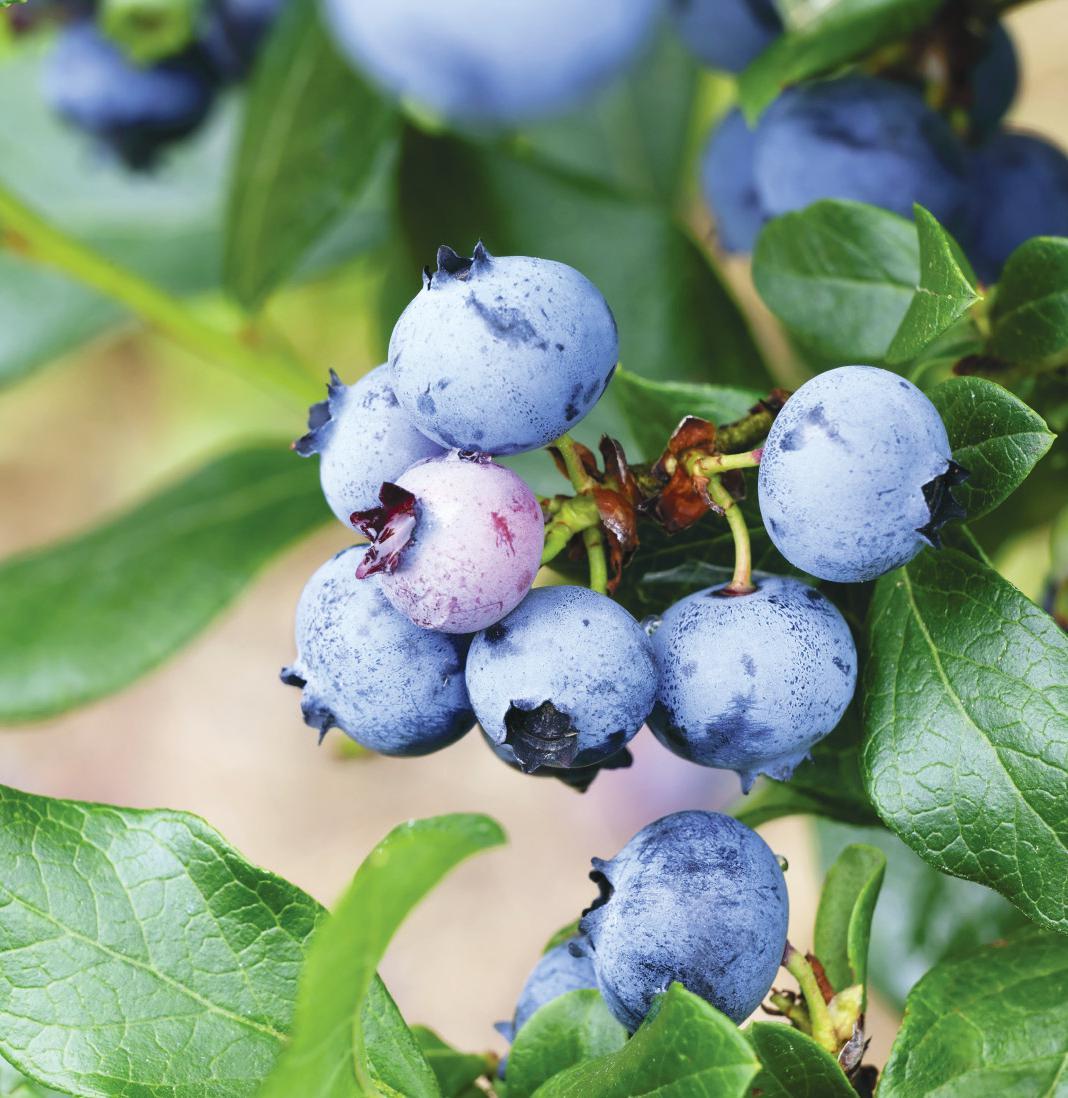
40 | The Blueberry News FloridaBlueberryGrowers.org THE SYSTEMIC COMBINATION FOR A S U P ERIOR B LUEBER R Y CR O P 800 -343 -77 75 • P.O. B OX 7 75 • ZEL LWOO D, FL 3 2798 • PlantFoodSystems.com K-PHITE ® 7LP and Sizer® XL are registered trademarks of Plant Food Systems, Inc &




















































































































































































